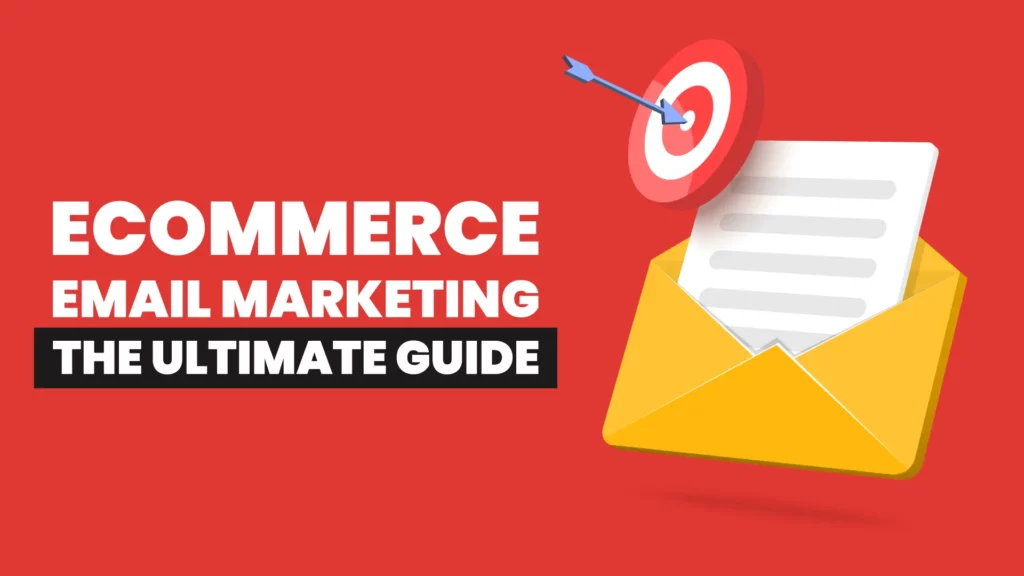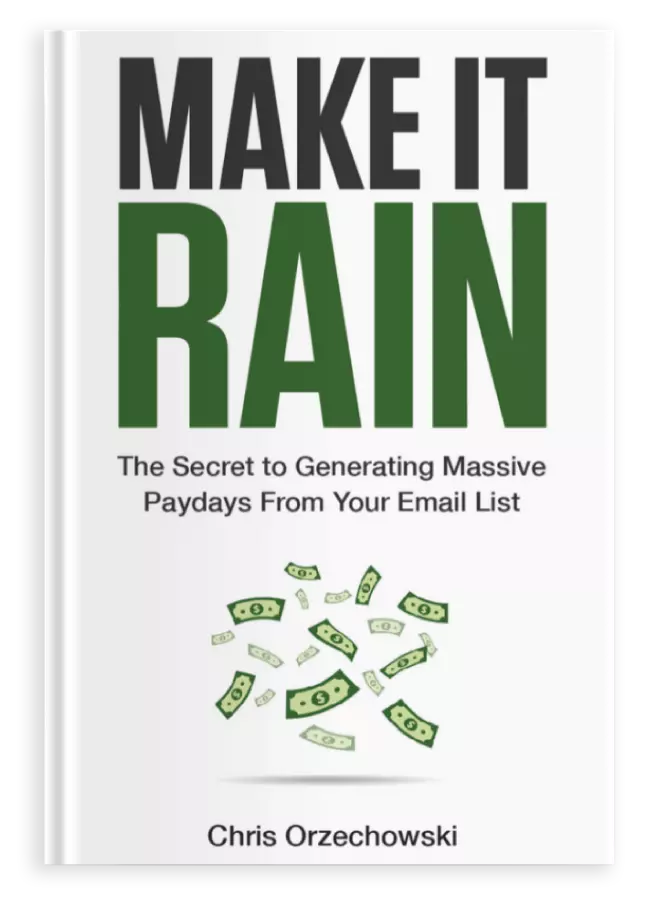The Ultimate Ecommerce Email Marketing Guide
If you’re looking to know everything there is to ecommerce email marketing related, look no further.
From best practices to examples, this guide has EVERYTHING you need to start kicking ass with your ecommerce email marketing.
The Ultimate Guide To Ecommerce Email Marketing
Ecommerce Email Marketing 101
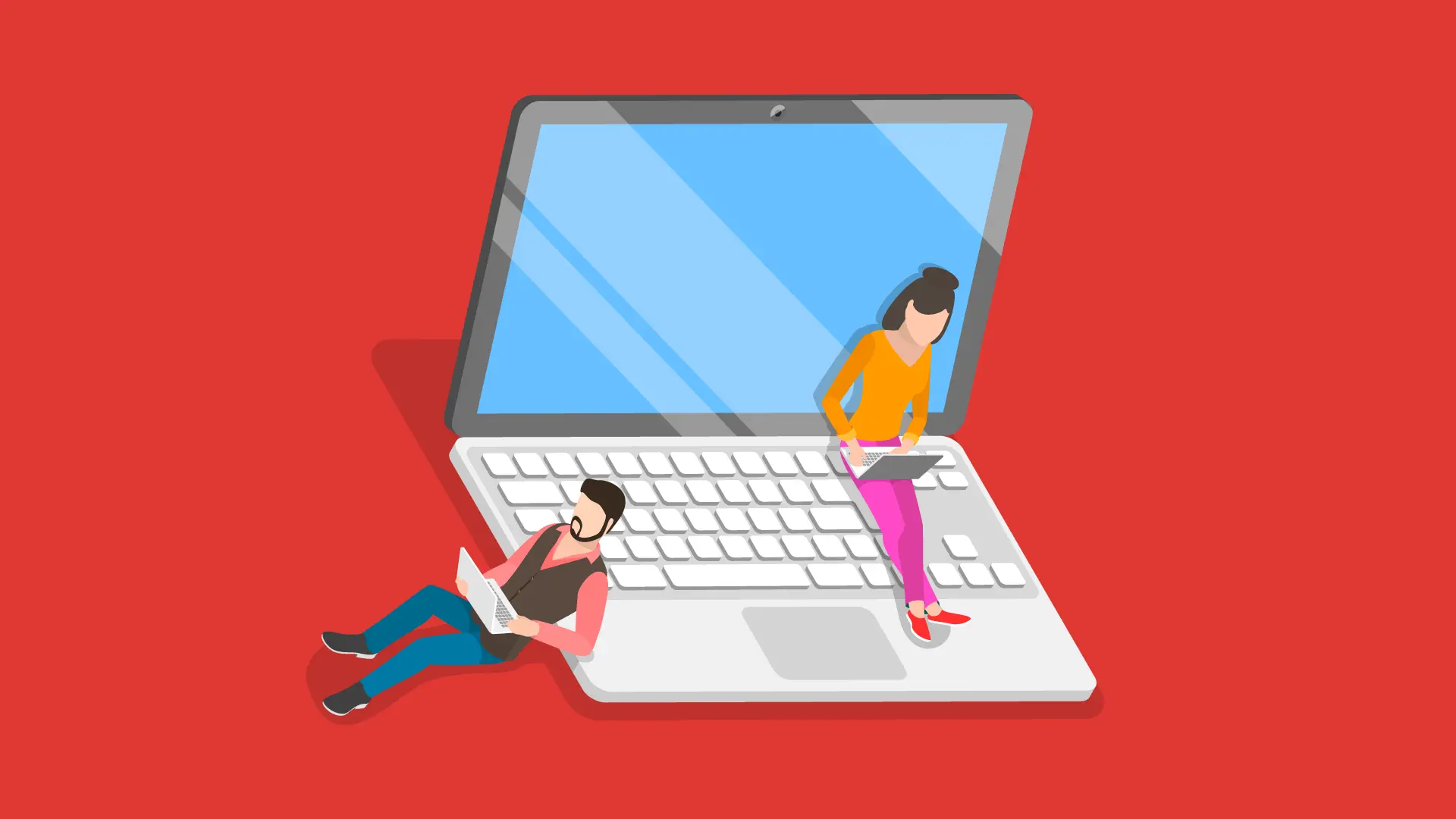
Before we start our deep dive into email marketing, let’s go over some of the basics and frequently asked questions.
What is ecommerce email marketing?
Ecommerce email marketing is when a business uses the medium of email to broadcast a message to one or (usually) several people.
In some ways, it’s a digital form of direct mail marketing, which is where businesses use mailing services to ship out flyers, letters & brochures to a series of physical addresses.
The big difference here is that ecommerce email marketing uses email addresses and you can do A LOT more than just send flyers. More on that in the later sections.
How did ecommerce email marketing start?
The email system itself was first invented in 1971 by Ray Tomlinson.
Then in 1993, the first Web Mail (email that could be accessed via browsers) was developed by Phillip Hallam-Baker.
As civilization moved into the 2000s, it became more common for people to have email addresses.
With every person needing an email address in some form or another to access the Internet, it wasn’t long until businesses realized they could email people to communicate updates and generate sales just like they were doing with direct mail marketing.
How is email marketing useful for ecommerce?
Well… most of the time an ecommerce business doesn’t have an actual physical location for customers to visit. They usually only have an “online storefront” for people to browse and buy from instead.
Because of this, ecommerce brands send emails as a means of directing traffic over to their product pages so they can generate sales.
Not to mention, email marketing allows ecommerce brands the ability to communicate directly with potential buyers at scale AND at an incredibly low cost.
For the sake of comparison, direct marketing can cost anywhere up to hundreds of thousands of dollars as the volume of recipients increases (due to printing & shipping costs)… whereas sending an email to either 10 or 100,000 people only goes up by a few dollars.
Also, while people may move around and change physical addresses from time to time, they rarely change email addresses as frequently.
Which means as long as you have people subscribed to your email list, you don’t have to worry about losing the ability to communicate to them for a very long time.
Is it possible to engage in ecommerce email marketing without knowing any tech?
Absolutely.
Nowadays, most email service providers are incredibly user friendly, making it easy for anyone to get the hang of things in just a few hours.
Most of these softwares come with lots of support in the form of:
- Simple tutorials that you can either read or watch
- Community boards where you can ask questions and learn from others
- Dedicated support staff who can help guide you towards answers
Beyond that, there’s SO much content out there in the form of blog posts, written guides and videos that can help you master the tech you’re using.
All it takes is a bit of Googling and you’re sure to find whatever answers you’re looking for.
But hey, if you don’t want to deal with any of it yourself… you can always just outsource everything to an email marketing expert who can take care of it all for you.
The truth is most ecommerce brand owners & managers don’t handle the actual technical work directly. Instead, they get a team that handles the execution for them.
How much does it cost to do ecommerce email marketing in 2022?
Relative to most marketing channels, not a whole lot!
Although it’s hard to provide an exact number.
At a super basic level, building a list and sending emails to subscribers can cost as little as $25/month.
But the cost can easily go up based on:
- Upgrading your package to increase your list capacity
- Switching over to more advanced platforms with more features
- Hiring employees or freelancers to manage your campaigns for you
Don’t let that scare you though.
Because usually if your email marketing costs are going up, that means business is booming… and you need to scale to keep up with the growth.
Is it possible to send out TOO many emails?
Is it still possible to make money from ecommerce email marketing today?
1,000%
In fact, let’s look into that a bit more with the next section…
Why Ecommerce Email Marketing Is More Important Than Ever
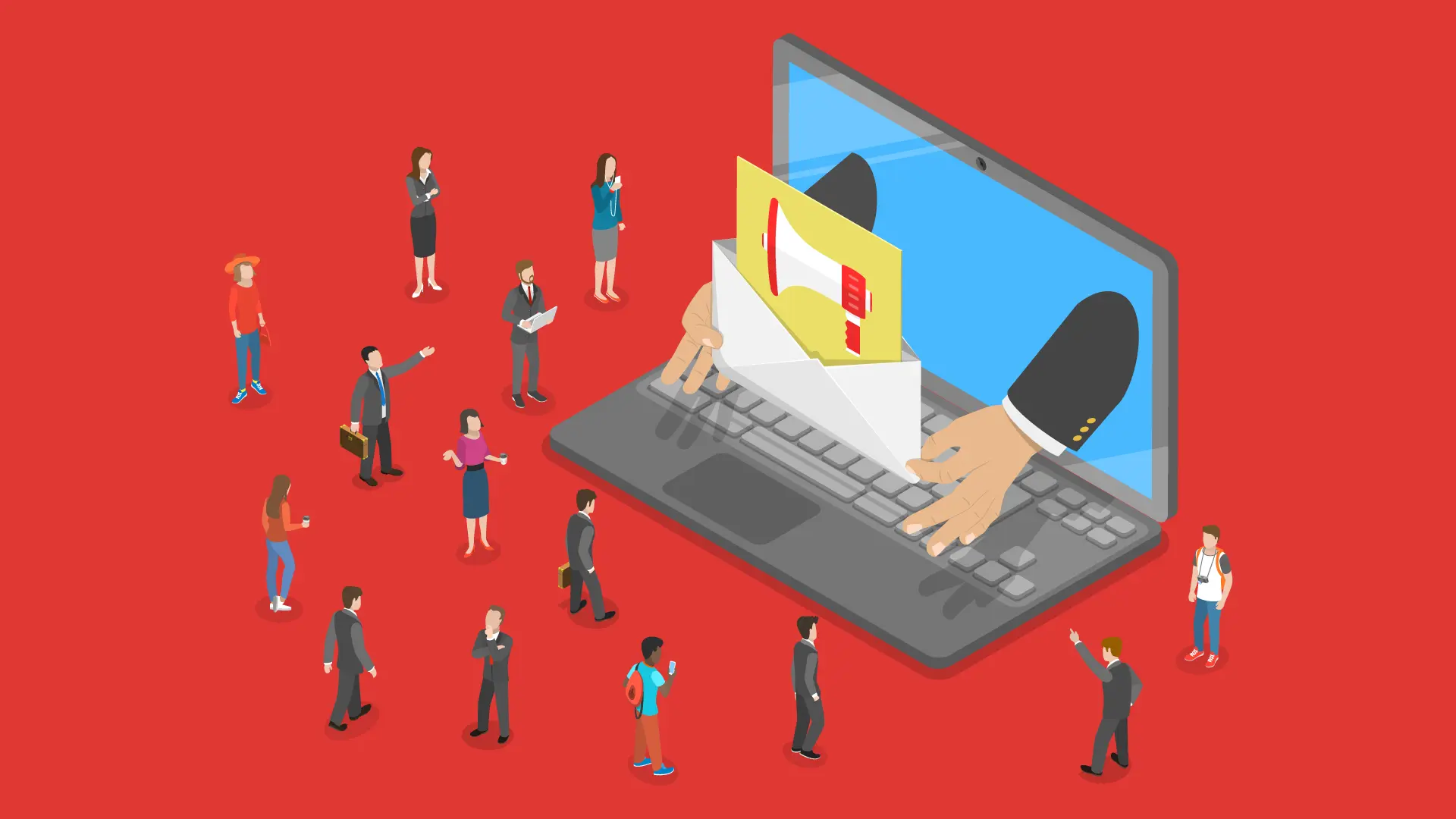
Since I started my career back in 2013, I can’t tell you the amount of times I’ve heard people say, “Email is dead”.
If you ask me though, I believe ecommerce email marketing is getting MORE and MORE important with every passing year.
Think about it…
There’s MORE email service providers, solutions and software options than ever before.
MORE email copywriters, marketers & agencies than there was in prior years.
And even MORE people opening and buying from email with each passing year.
Clearly email isn’t dying.
If it were, my agency wouldn’t be constantly meeting and working with ecommerce brands who want to build up and scale with email marketing.
So why is it that these companies want to invest in their email marketing?
Because in doing so, it’ll allow them to:
- Increase cash flow and long-term profitability
- Downplay high costs associated with the customer life cycle
- Build a brand that their customers absolutely love buying from
- Establish a reliable way to maintain communication with their audience
Let’s unpack each of these motivations for a bit…
Increases cash flow and long-term profitability
Thanks to the power of automation emails, brands can easily generate sales on any day and at any hour automatically.
Once the emails are written and programmed to send whenever a certain condition is triggered, ecommerce brand owners and managers can just walk away and let the automations do all the work for them.
Since there’s no real cost to these automations firing off on their own, it just means more revenue (and profits) for the business.
And that’s just with automations.
Because otherwise, an ecommerce brand can simply plan out its calendar and put out the right number of broadcasts and launches to achieve its monthly revenue goals in a predictable fashion.
Downplays high costs associated with the customer life cycle
One of the toughest parts of managing the customer life cycle for ecommerce brands is downplaying the sky-high acquisition costs that come with getting new customers through paid advertising (like Facebook, Instagram and YouTube ads).
The reality is that ad costs always shoot up… which means a business needs to ensure it’s making WAY more revenue so that it’s profitable and able to scale.
And while it may be easy to acquire new customers by spending more on ads, the better strategy long-term is to maximize how much and how long those customers are buying from you once they’re in.
Thankfully, by leveraging the power of ecommerce email marketing, brands have an opportunity to dramatically increase their customer’s lifetime value (CLV) and offset the heavy costs associated with acquiring them in the first place.
In short, paid ads gets customers, email marketing keeps them spending long-term.
Builds a brand that customers absolutely LOVE buying from
A key quality that really sets ecommerce email marketing apart from most marketing channels is the intimate nature of the inbox.
Even though an ecommerce business is mailing several people, the recipient’s experience still feels like it’s a personal 1-on-1.
Not to mention, they can directly message you by just hitting reply… and talk to you more comfortably than they would on social media (where everyone’s watching).
Where social media feels more like you’re hanging out at a bar… the inbox feels more like you’re having drinks at a friend’s.
This is why you don’t want to ruin your stay by spamming them with only “buy my shit” emails.
Instead, you want to use email as an opportunity to build a bond with your readers by writing to them in a way that’s more conversational and human.
Every email acts as an opportunity to build on the relationship you have with your customers… and to make it so that when they’re ready to buy, you’re always top of mind and the #1 choice.
Establishes a reliable way to maintain communication with your audience
While social media platforms like Facebook, Instagram and YouTube are fantastic mediums to build an audience with, it’s ultimately on “rented land”.
If anything were to ever happen to a brand’s account or the platform itself, access to that entire audience would be lost immediately… without much recourse for recovering the list.
But with email, it doesn’t matter what happens to those platforms.
You always have a list of people who you can contact no matter what.
And if you ever want to switch over from one email service provider to another, you can simply export your list and move everyone over to your new setup.
Last but not least, your ability to reach people on social media with your campaigns is always at the mercy of updates made to that platform’s algorithm and/or Terms of Services.
Meaning you can see a sudden decline in performance without knowing what to do to get it back to where it was prior to the update.
This is definitely not as much of an issue with email marketing.
Three Ways To Create Customers With Your Ecommerce Email Marketing
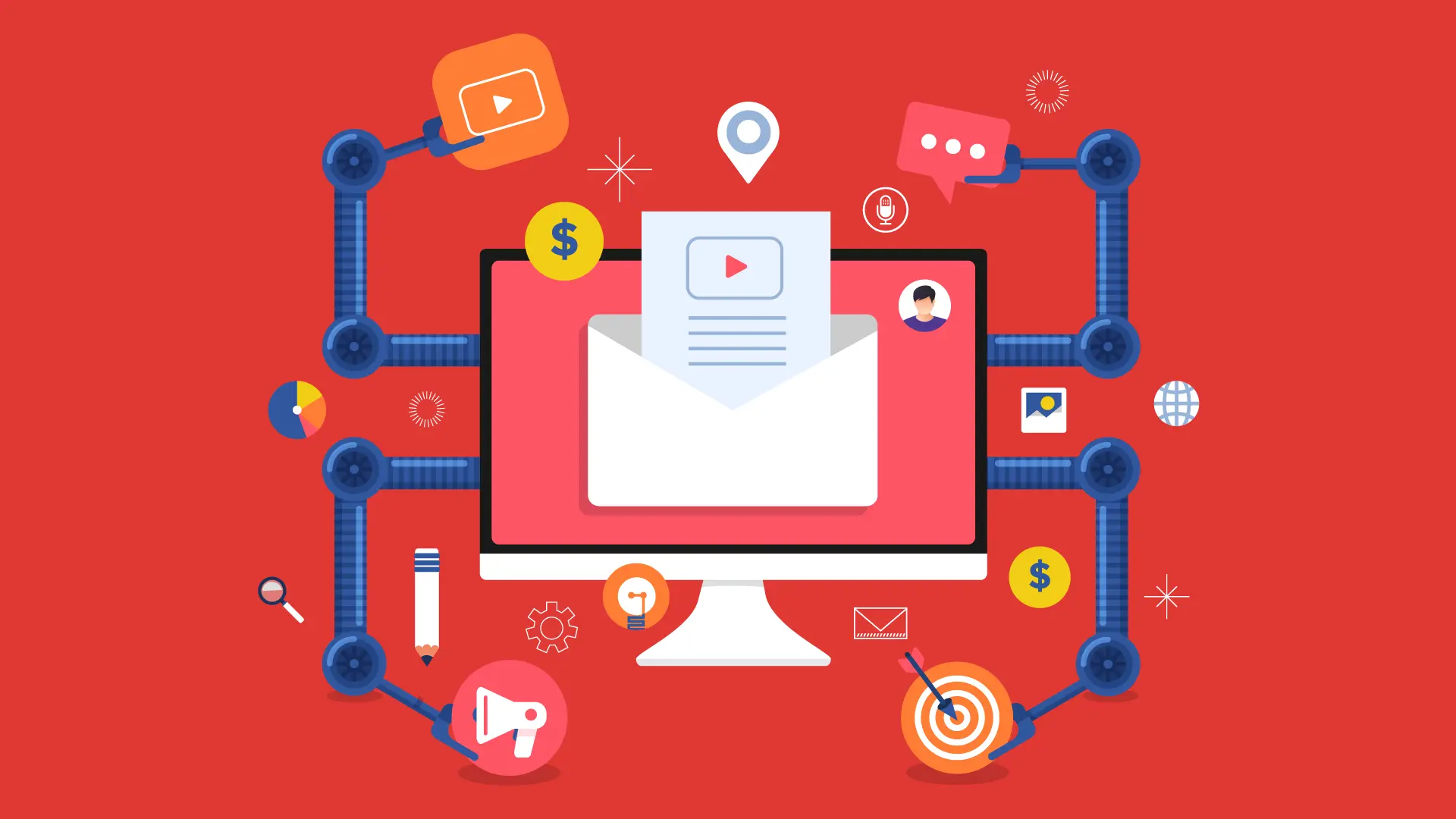
When emails first started getting popular back in the early 2000s, email marketing was pretty simple.
You could send whatever you wanted. And for the most part, it was the same approach as direct mail flyers where you showcase all your latest promotions with pretty designs.
But the game has changed quite significantly since then.
Since that’s what everyone was doing (and some are still doing today), a more sophisticated strategy is needed to stand out from the noise these days.
Here’s the thing though:
If your brand has great offers that solve the pains & problems of your core audience, it’s actually incredibly easy to make sales with emails.
And for the most part, there’s 3 main ways to email your list:
- Automation Emails
- Broadcast Emails
- Launch Emails
But before we get into that, let’s talk about how most ecommerce brands get people to opt into their email list first.
Getting Subscribers On Your Email List
To get site visitors to sign up to their email list, most ecommerce brands:
- Provide an incentive to sign up.
- Use an opt-in form to collect the person’s information.
Let’s take a look at some of the main incentives you can use to get people to sign up to your list.
5 Incentives E-Commerce Brands Use To Convert Site Visitors Into Subscribers
For the most part, ecommerce brands use one of the following incentives to get visitors to turn into subscribers:
- Discount codes (usually X% off the first purchase.)
- Free shipping (on the first order.)
- Store credit (that can be used when buying for a minimum of X$.)
- Contests (with a chance to win something big for just signing up.)
- Exclusive offers (that are only available for email subscribers.)
Which incentive is the best choice for your business?
Well… that depends on how well you know your ideal customer.
For example, if you’re an ecommerce brand that sells coffee, offering free shipping is probably fine.
But if you’re able to offer them a 2nd bag for free on their first purchase, your conversion rate will probably be A LOT higher.
(Assuming you know for sure that your customers value getting more product over saving a few bucks on shipping…)
Once you’ve got an incentive figured out, you’ll want to figure out how you’re presenting the information to your site visitors.
Let’s take a look at how most ecommerce sites present their incentives and opt-in forms.
Standard Opt-In Forms
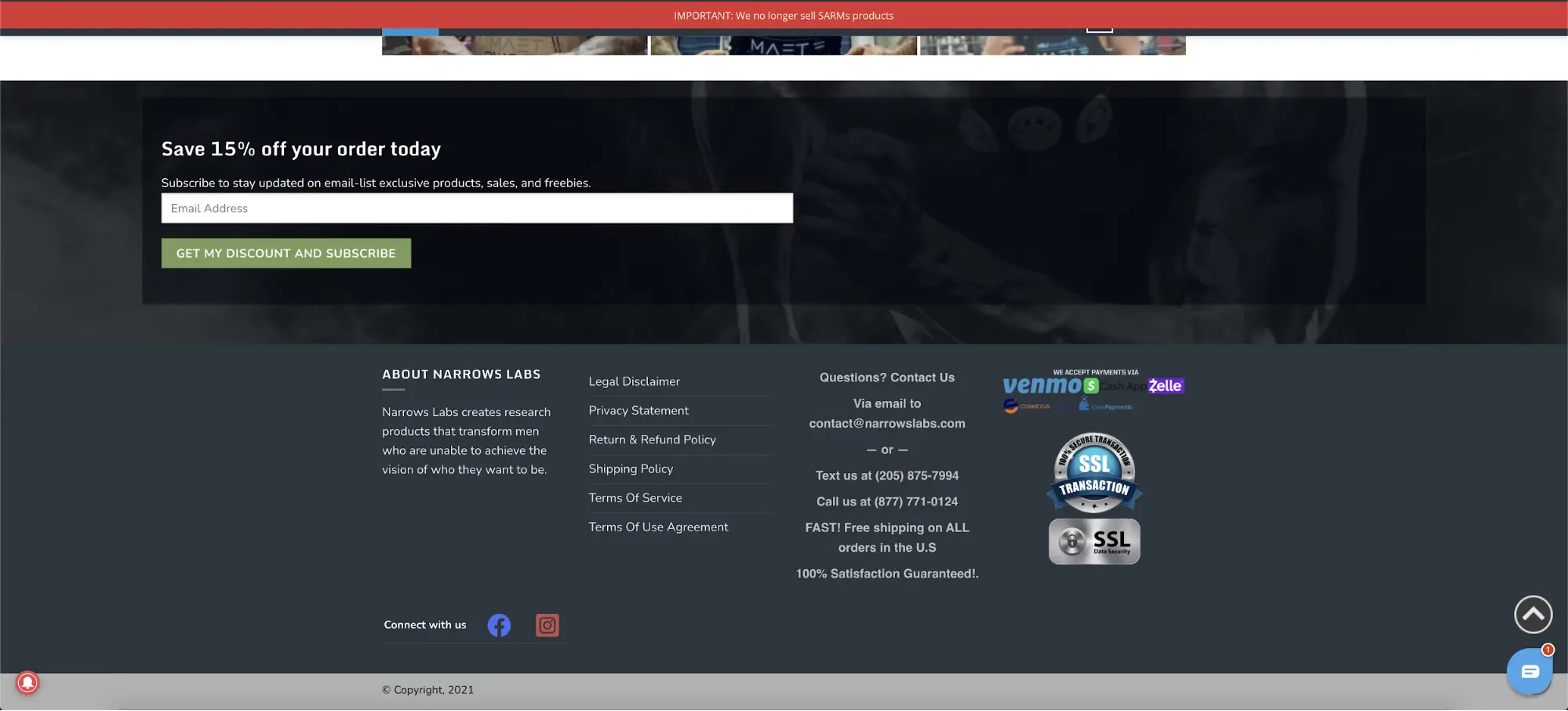
(From Narrows Labs)
When it comes to getting people to sign up to their email list, most sites have a form somewhere on their homepage.
This might be inside a sidebar or footer section of their pages.
It’s the most standard opt-in form you’ll find on any site.
Although to be completely honest, it won’t get you tons of subscribers on its own.
In most cases, ecommerce sites use this with OTHER types of opt-in forms to get tons of new people onto their list.
Welcome Pop-Up Forms
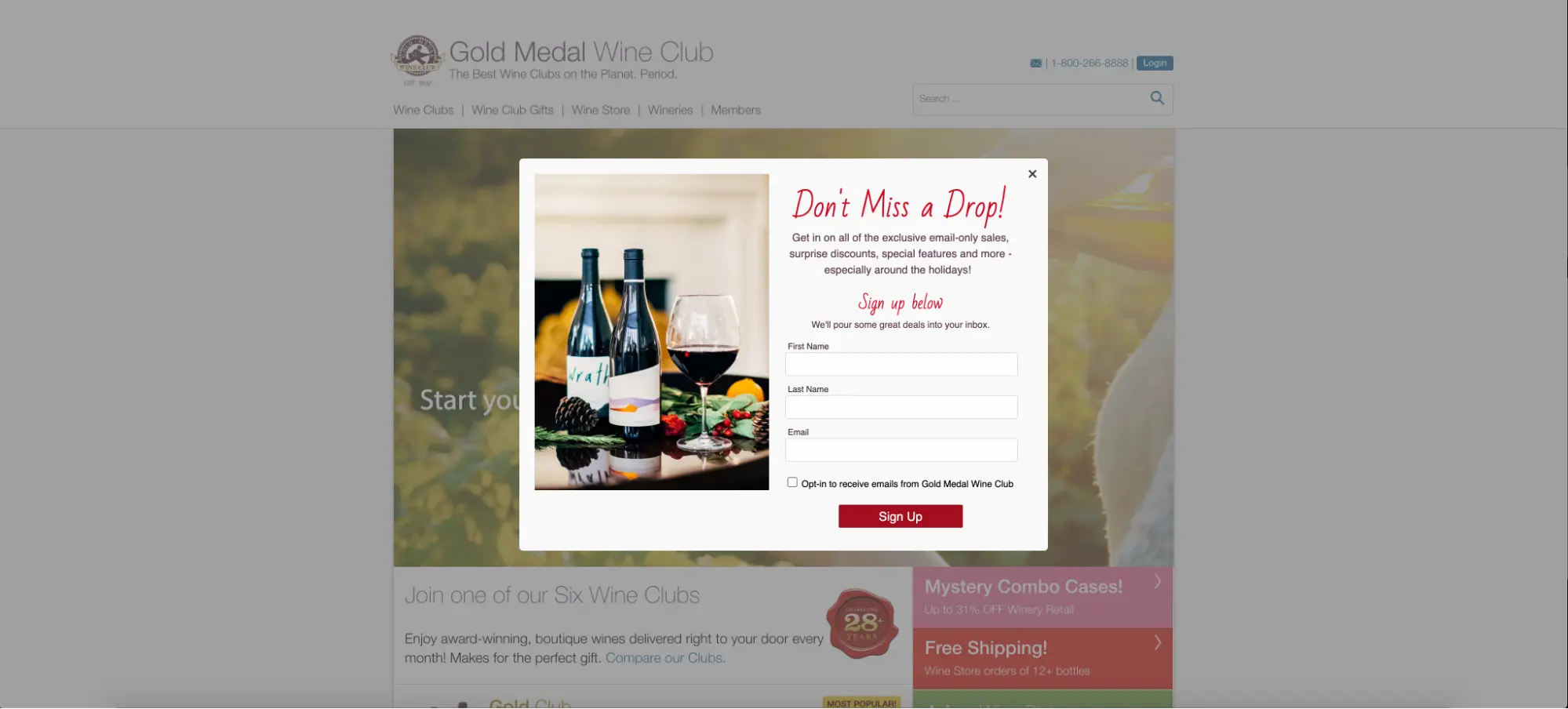
(From Gold Medal Wine Club)
The more common and effective approach to getting new subscribers is the welcome pop-form.
The way this form works is that it waits for a few seconds (usually 5 to 10) to pass by before “popping” up in front of the person.
Now, many people will tell you that these forms are kind of annoying… but the numbers show that they actually perform incredibly well.
It makes sense if you think about it…
A pop-up form is only annoying if you’re trying to show the person something they don’t care about.
In other words, if you know your ideal customer incredibly well (which you should) and your pop-up is designed to show them something you know they’ll want, then your pop-up will act as a pleasant surprise instead of an annoyance.
Exit Pop-Up Forms
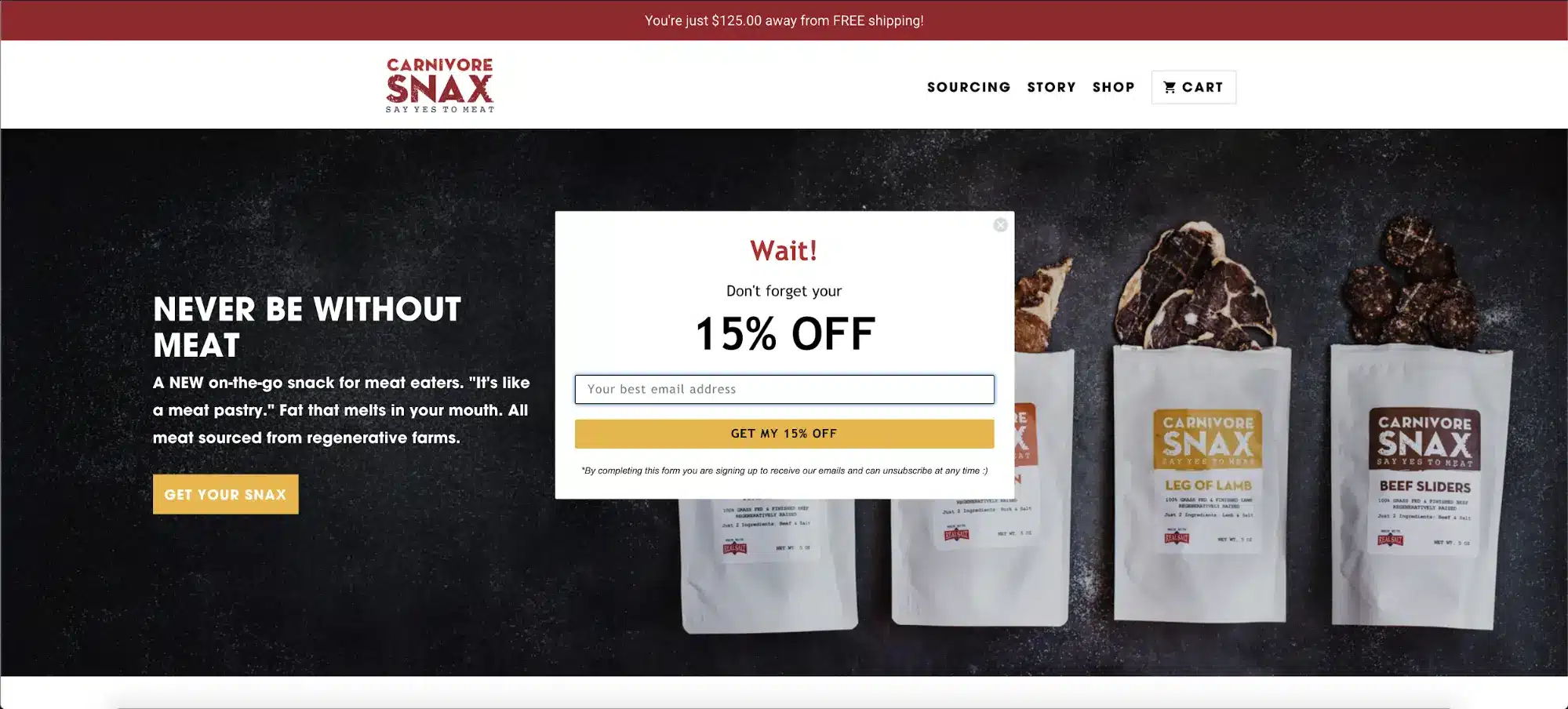
(From Carnivore Snax)
Another great way to get more subscribers is the exit pop-up form.
It’s pretty much the opposite of the welcome pop-up form.
Instead of showing up at the beginning, it shows up when it thinks the person is about to leave the site (usually off tracking the mouse cursor moving towards the X button in the corner of the browser).
Some call it a “last ditch effort” style pop-up form.
But it works well in getting subscribers, so it’s definitely worth a shot.
Contest Pop-Up Forms
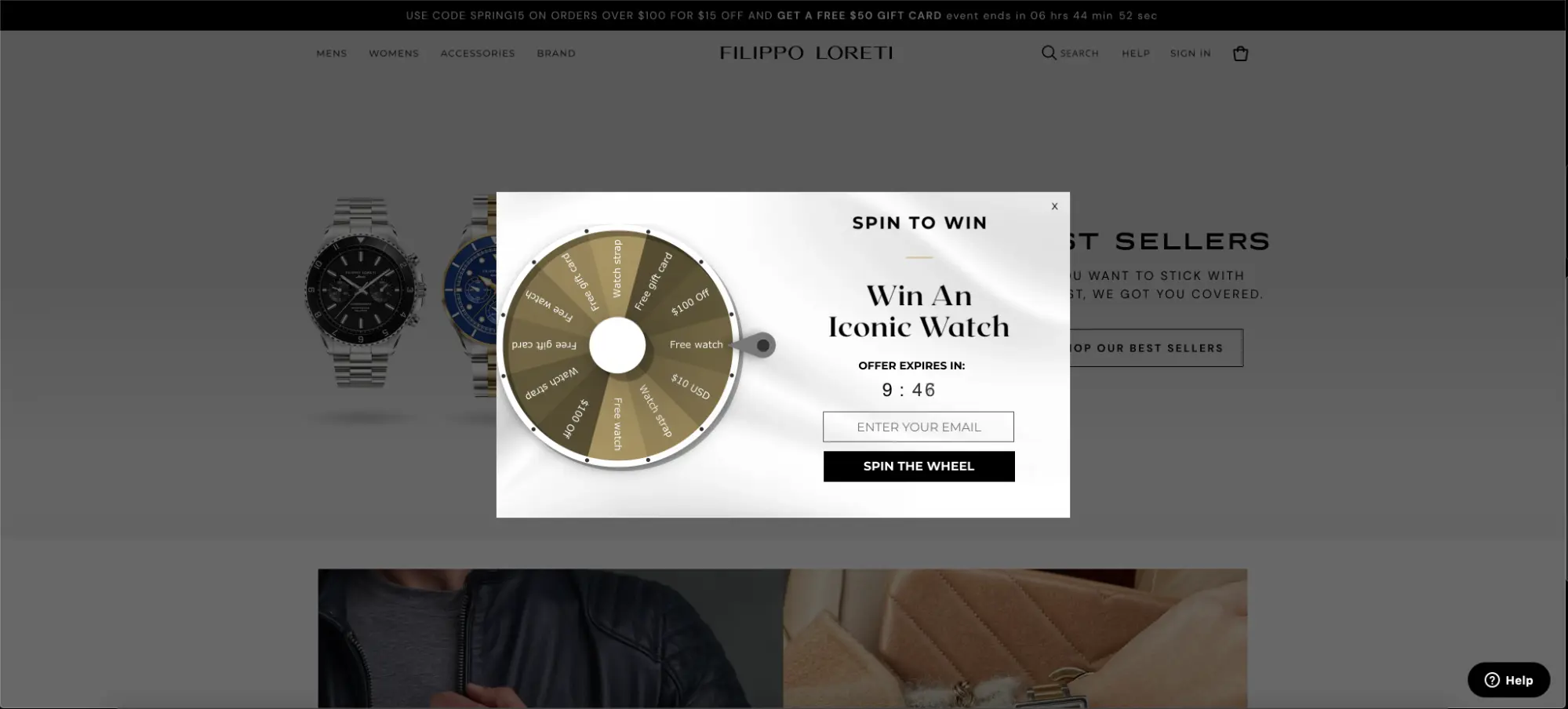
(From Filippo Loreti)
Everyone loves a good contest.
For ecommerce brands, using a contest where you’re giving away some of your products is a fantastic way to get people onto your list.
A contest pop-up form works exactly like a welcome pop-up form in that it pops up after a few seconds of the person loading up your page.
The difference is that it’s much more exciting because it’s an opportunity for them to get something free for just giving you their email.
If you’re a high-end ecommerce brand like Filippo Loreti that sells expensive watches, it’s going to be really hard for your ideal customer to pass up on a chance to win.
Quiz Style Forms
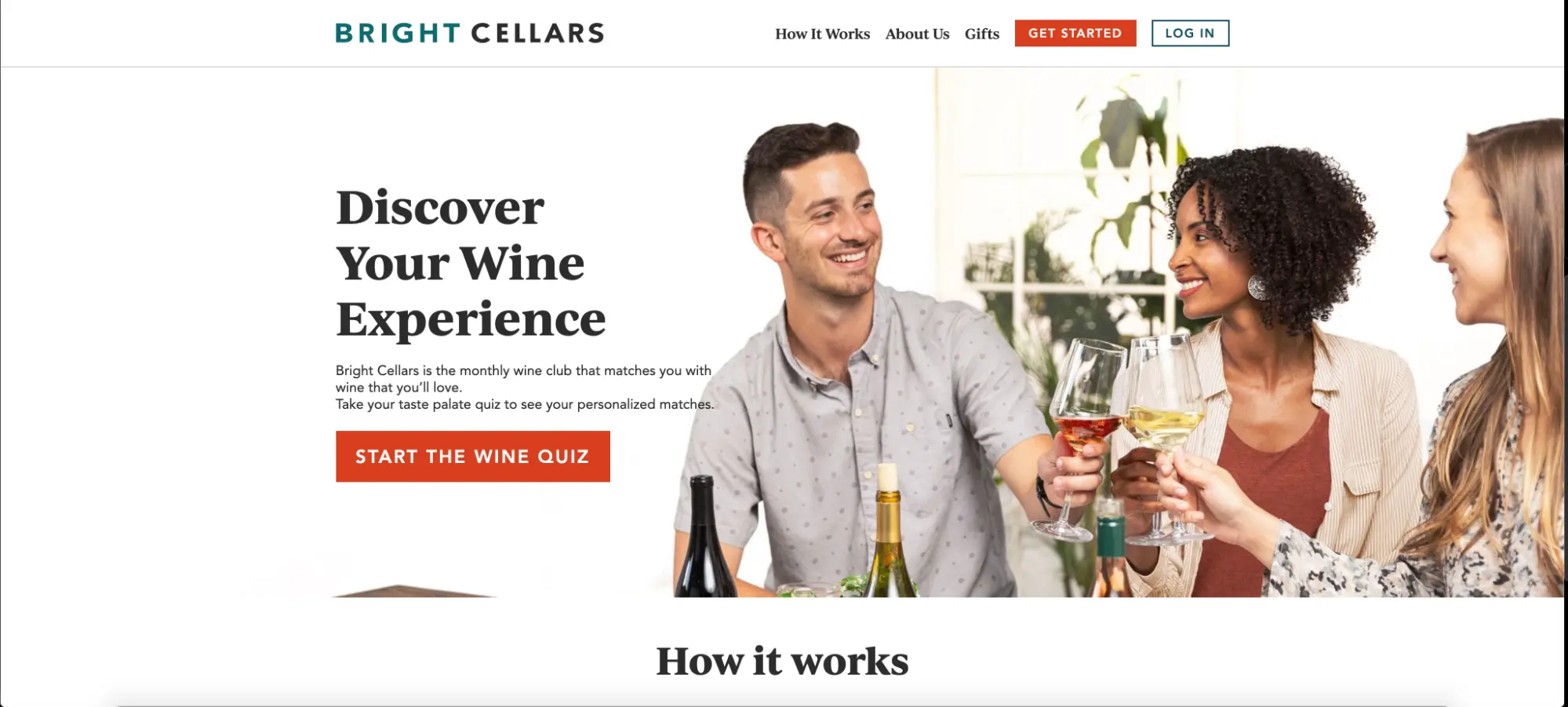
(From Bright Cellars)
Many ecommerce brands are starting to use quiz style forms as a more engaging way to get people to sign up to their lists.
People generally enjoy doing quizzes because it gives them an opportunity to learn more about who they are and what their preferences are.
For example, Bright Cellars uses a quiz to help the person find out what kind of wines they’re into.
Again, they know their customers REALLY well. They know that their customers love wine, but aren’t necessarily knowledgeable when it comes to picking out the right bottles.
So the quiz actually solves a common pain point most of their customers have.
Not only does it provide insight to the person taking the quiz, but it also gives the brand TONS of information on how to recommend the right products to that person for a more personalized shopping experience.
Overall, quizzes are a fantastic new way to get tons of subscribers joining your email list.
Automation Emails
Automation emails (or flows) are emails that are sent to people on your list automatically when a certain condition is triggered.
The first automation that usually fires off is a “welcome sequence” of emails, which gets triggered when someone joins your list for the first time.
As I mentioned earlier, the beauty of automated emails is once they’re written and set up properly, it’s totally hands-off afterwards.
That means you can just walk away and it’ll continue working for you in the background 24/7… helping your subscribers buy from your brand.
For ecommerce brands, there are mainly 3 types of automation emails to consider:
- Before The Sale Emails
- During Fulfillment Emails
- After The Sale Emails
Before The Sale Emails
Before the sale emails are automation emails that aim to get first time subscribers (or anyone who isn’t a customer yet) to make their very first purchase with your brand.
Emails that fall into this category include:
- Welcome Emails
- Cart Abandonment Emails
- Browse Abandonment Emails
- Stock Update Emails
- Still Alive Emails
Welcome Emails
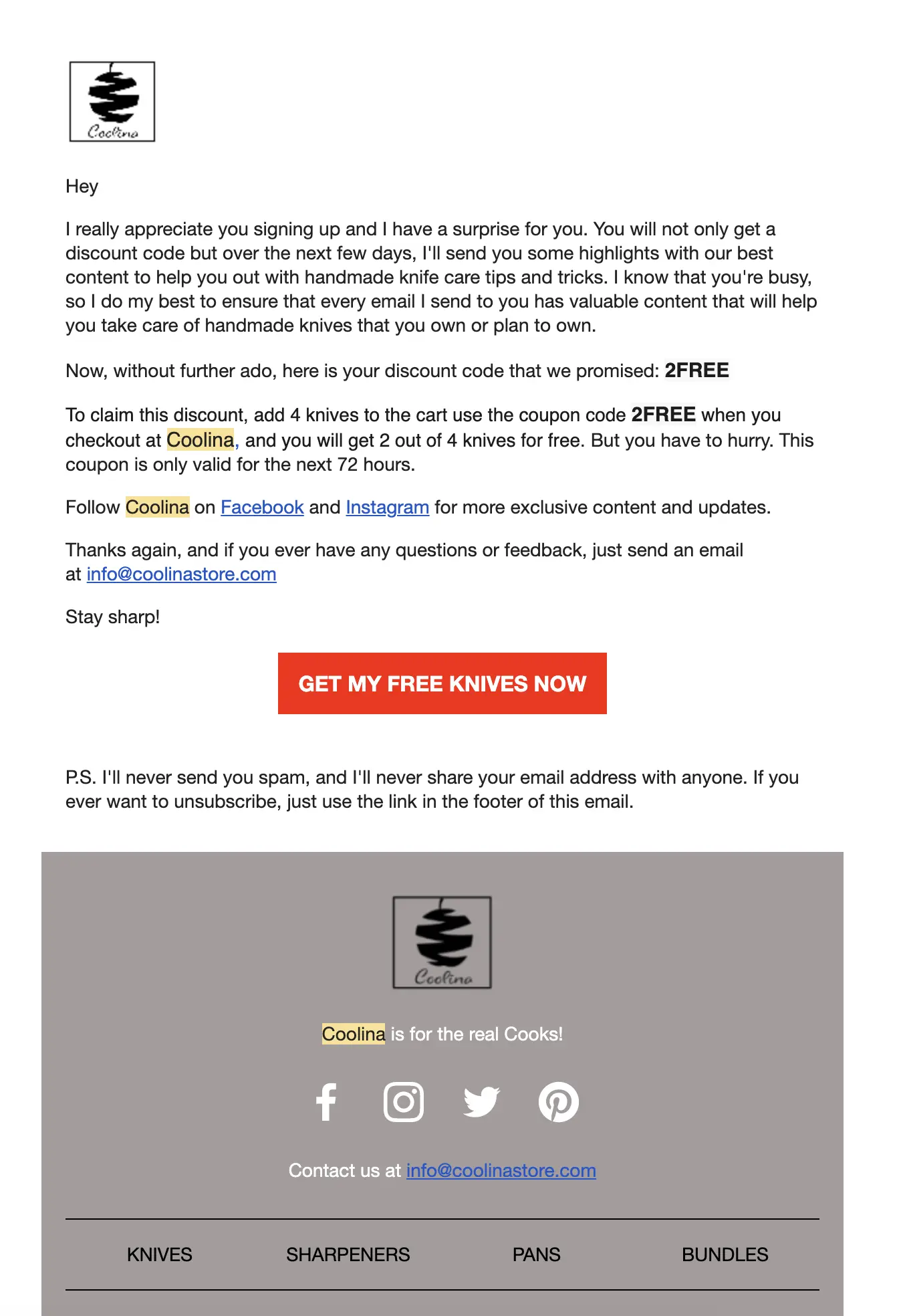
(From Coolina)
Welcome emails get sent out to people automatically when they sign up for your list.
The rest of your welcome emails can be an opportunity to:
- Tell them a bit about your brand and its origin story
- Go over what makes your products so special
- Celebrate your customer success stories
- Share cool behind the scenes stories from the office
When done right, these emails help form a bond with your new subscribers and can get them to make their very first purchase with you.
We recommend having at least three emails in this sequence. But honestly, we’ve even seen some welcome sequences that are 30+ emails long.
You can start with a few emails and expand with more over time as your ecommerce email marketing grows more sophisticated over time.
Browse Abandonment Emails
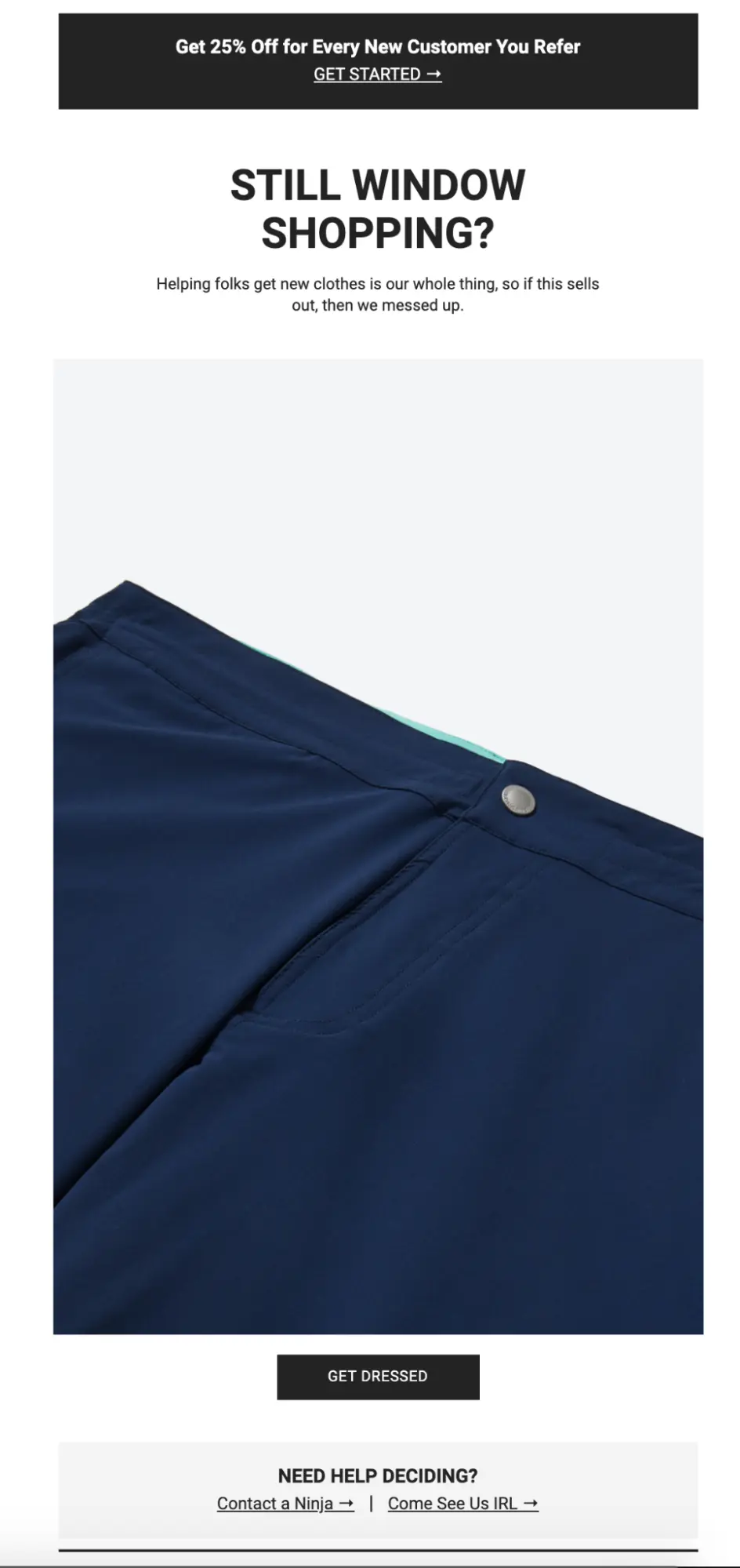
(From Bonobos)
Browse abandonment emails get sent out automatically to people when they’ve viewed an item on your site once, but didn’t add it to their cart.
It’s crazy the amount of sales you can get from site visitors who are essentially “window shopping”.
This is especially true if your site is getting TONS of traffic volume every month…
Now, most people would argue that if someone didn’t add a product to the cart, it must mean they’re not interested in buying.
This isn’t necessarily true.
Sometimes people are interested in the product, but might need more information to finally feel confident enough to make the purchase.
In fact, sometimes they’re comparing your product with those of other brands.
If your brand is the one that’s reaching out with emails and is providing a lending hand to help answer their questions and concerns, that makes your brand stand out way more from the competition.
As for how many emails you should include, we’ve found a lot of success with using 3 emails with our clients here at the agency.
Cart Abandonment Emails
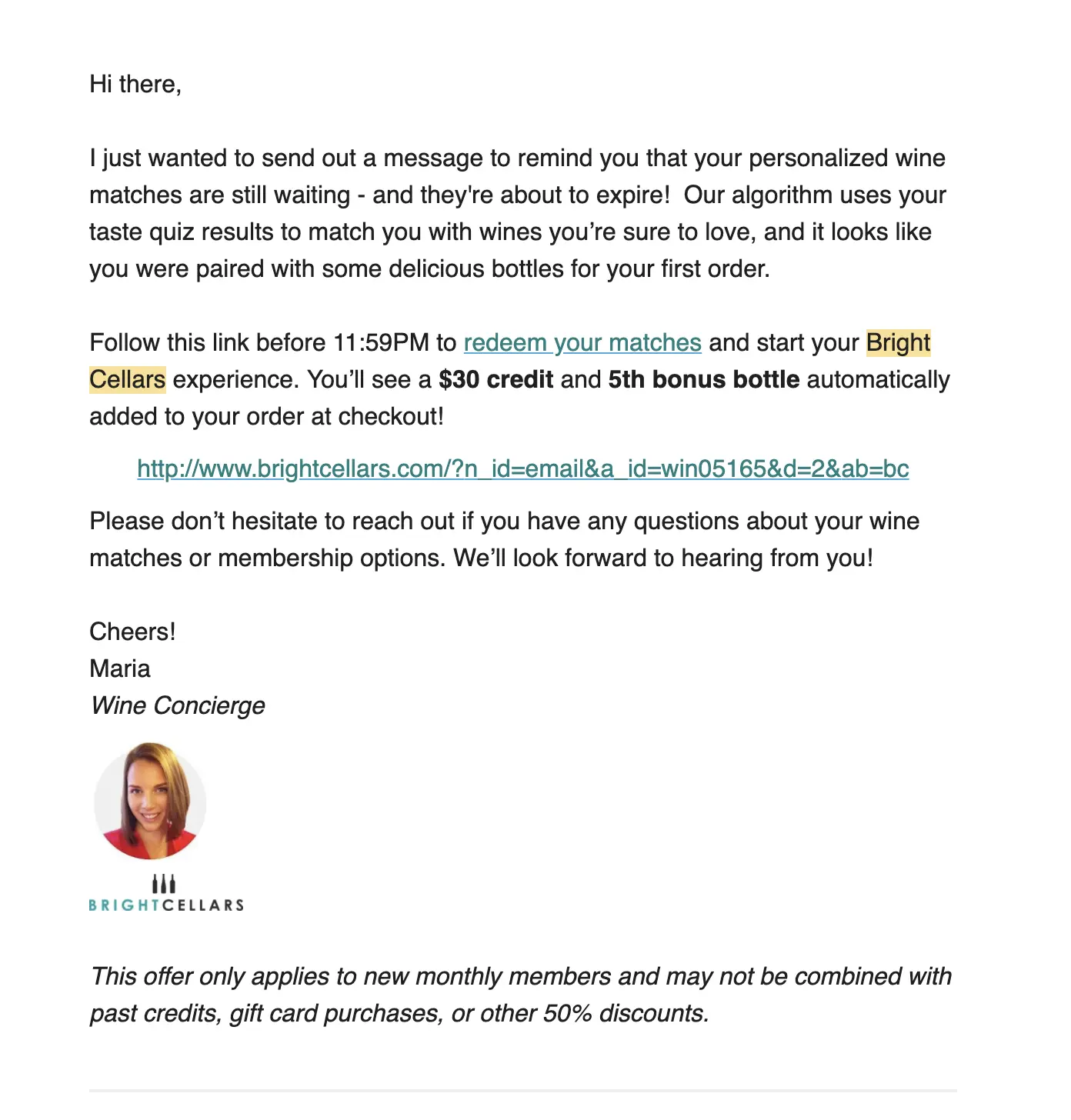
(From Bright Cellars)
Cart abandonment emails get sent out to people automatically when they’ve added an item on your site to their cart, but didn’t place an order.
Whenever we speak with a new client at the agency, one of the very first things we look at is their cart abandonment sequence.
I consider it the “low-hanging fruit” in most ecommerce brands.
Just getting a few of these emails set up can easily start recovering a chunk of sales for your business every month.
While you might not recover 100% of your abandoned cart, any percentage is better than none.
Now just like with browse abandonment, some argue that if a person didn’t buy your product, it’s because they’re not interested.
Again, this isn’t necessarily true.
Sometimes people get distracted and just forget to finish buying your product.
Other times, it’s like the people who are browsing your products… and they may need their questions and concerns answered before they can make a purchase.
In any case, it’s always best to get this set up as early as possible so you aren’t leaving money on the table.
Just like the browse abandonment emails, I recommend you set up at least three follow up emails for anyone who didn’t finish placing an order after putting an item in their cart.
Stock Update Emails
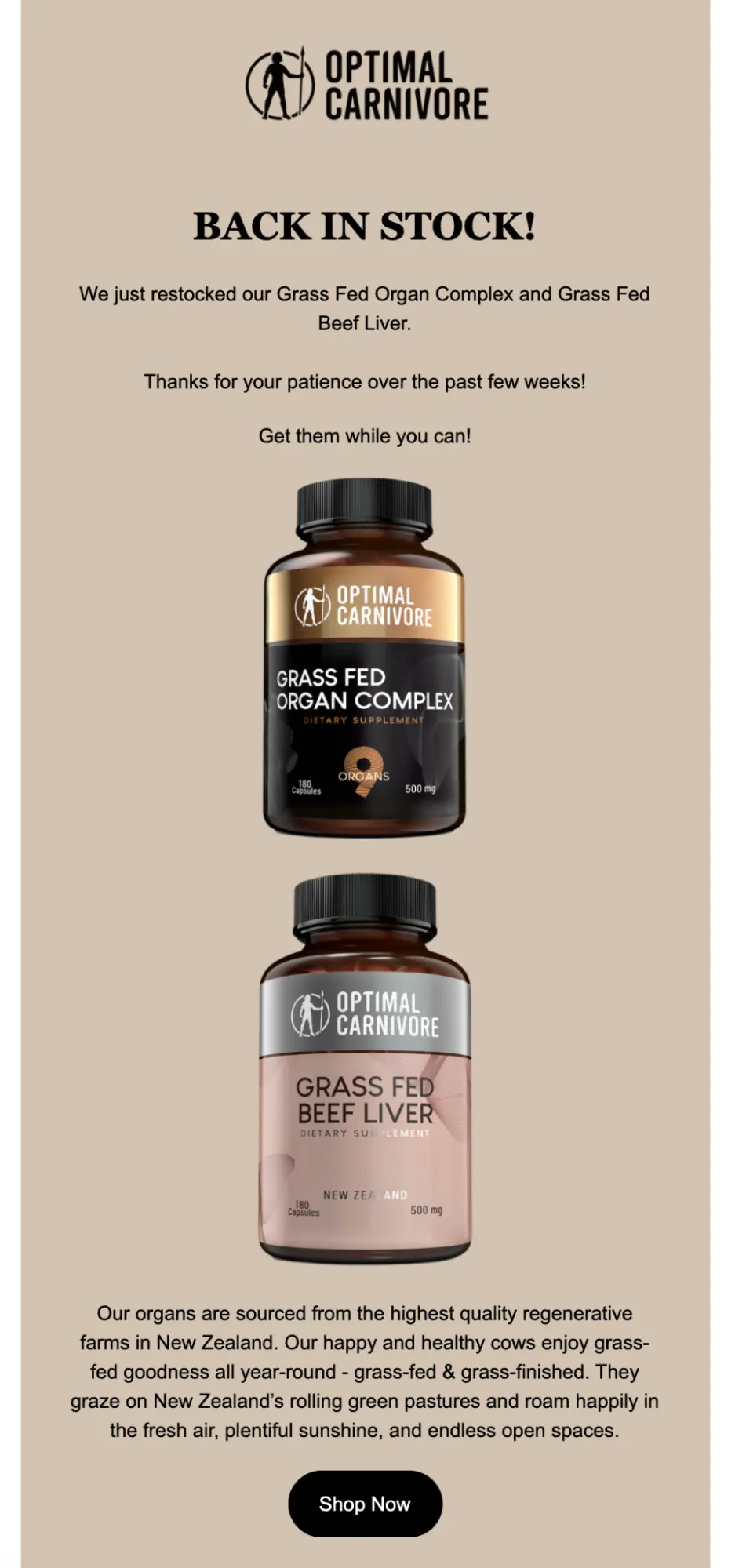
(From Optimal Carnivore)
Stock update emails get sent out automatically to inform subscribers when a product is out of stock and when it’s back in stock.
Some smart ecommerce brands set up a “waitlist” for people to sign up to so they can be the first to be notified when a product is back in stock.
Not only will this grow your list, but it’ll also generate a bunch of sales.
When someone joins the list, you want to thank them for signing up and use the opportunity to talk about other available offers and opportunities for them to consider in the meantime.
Of course, once you’ve got more stock and your system updates, an email will automatically be sent out letting the people in that list (or segment) know the product is finally available again.
As a best practice, it’s good to remind them how quickly you’ll run out again and that they shouldn’t wait up to place an order.
Still Alive Emails
Still alive emails get sent out automatically to subscribers who haven’t opened any of your emails for a long period of time.
It’s just a reality of ecommerce email marketing that you’ll always end up with a few people on your list who just never engage or buy from your emails.
They signed up to your list and maybe even opened a few emails in the beginning.
But when you look at their user profiles, you can see it’s been months (or years) since they last opened an email.
I refer to these inactive subscribers as “one-night stands”.
Because if you guys didn’t hit it off on that “first date”, chances are they’re just not that into you or your brand.
And in all likelihood, you’re probably going to scrub these people off your list.
But not before letting an automation reach out to them for you so you can see if they can be saved.
For this automation, you only really need one email written and loaded up.
Just a simple message that asks them if they’re still there and if they want to continue getting your emails or wish to unsubscribe (so it doesn’t mess with your email deliverability).
During Fulfillment Emails
During fulfillment emails are automation emails that help generate more sales during the fulfillment phase of the sale.
If your “before the sale” emails are working well, your subscribers are going to start turning into customers fast and the orders are going to come in like crazy.
But that doesn’t mean the sales stop there.
In fact, there’s plenty of opportunities to increase a buyer’s order value and generate even more sales even during this phase.
Emails that fall into this category include:
- Order Confirmation Emails
- First-Time Buyer Credit Emails
- Before It Ships Emails
- Shipping Update Emails
Order Confirmation Emails
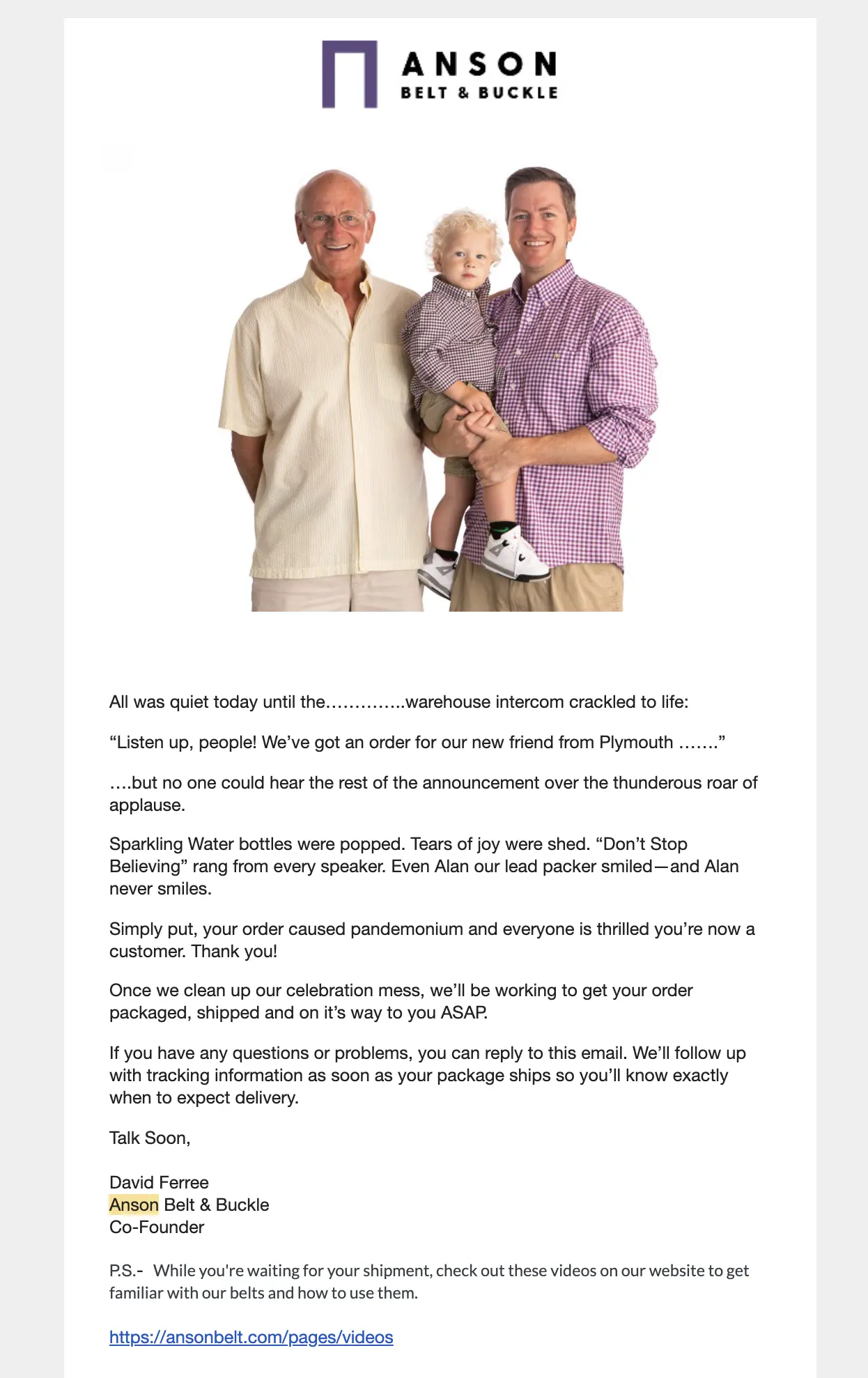
(From Anson Belt & Buckle)
Order confirmation emails get sent out to people automatically when they buy a product from your store.
When done right, these emails can build an incredible bond with your new customer and generate even more sales!
That’s why the best approach for these emails is to make them celebratory and fun.
Near the end of the emails, you can also recommend other products they can purchase, ask them to fill out a survey, etc.
Whatever you do, just don’t leave it as a generic transaction email.
After all, since people generally open their confirmation emails, it’s an opportunity for you to seize their attention with a well-placed message or two.
For this automation, you only really need one confirmation email written and loaded up.
First-Time Buyer Credit Emails
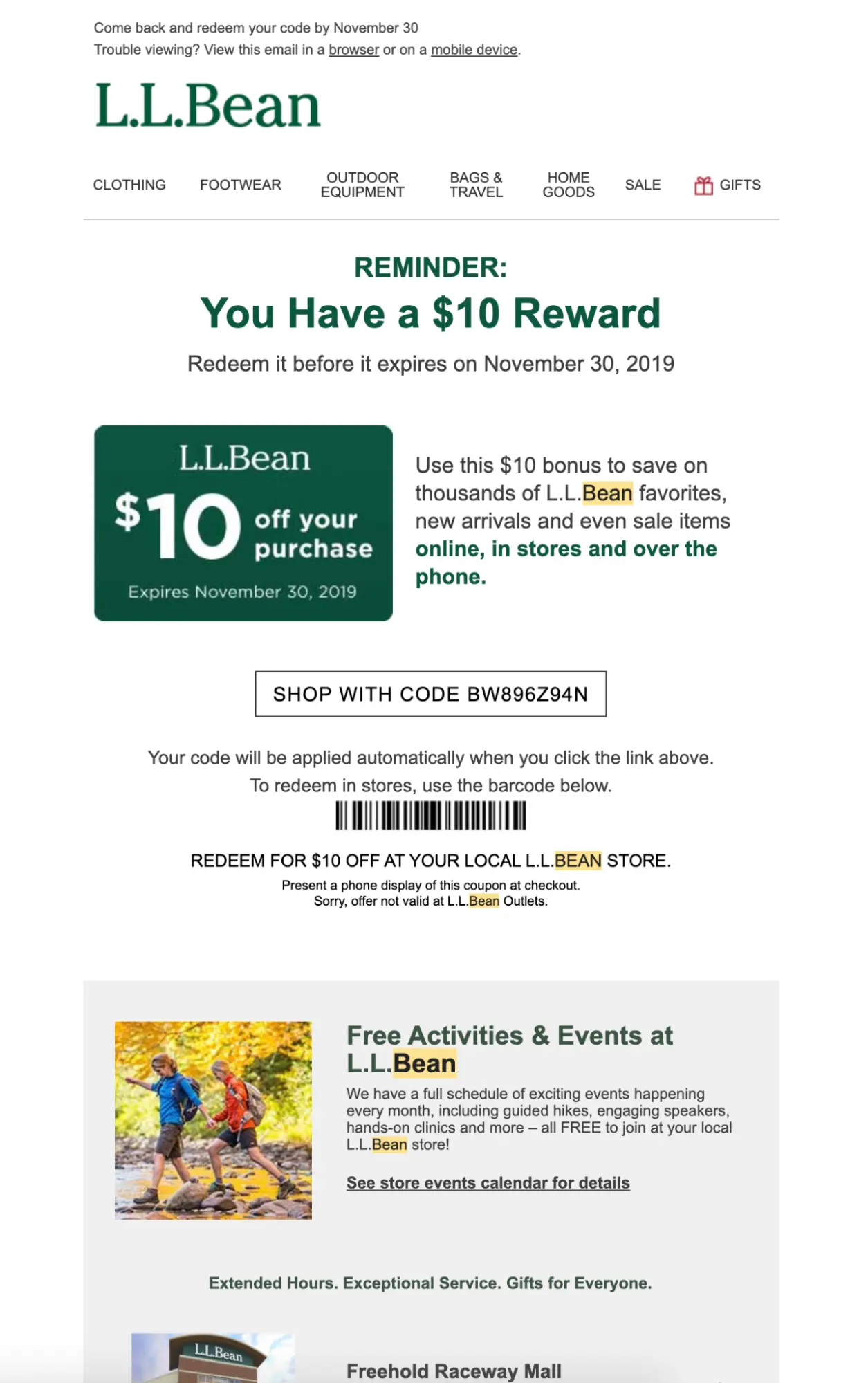
(From L.L. Bean)
First-time buyer credit emails get sent out to people automatically when they make their first purchase with your brand and gives them store credit to incentivize a second purchase before a given deadline.
Just as a heads up, this strategy isn’t for everyone.
But if you think it makes sense for what you’re selling, it’s definitely worth trying.
Compared to a discount, store credit feels a bit more tangible. It’s like money they already own and that needs to be used before it goes to waste.
That dynamic tends to encourage purchases better than a discount… which doesn’t really feel like they own anything (and therefore, can’t be lost).
For this sequence of emails, you could include up to 3 emails.
The first email can celebrate their first purchase by giving them the store credit and the two emails after can act as gentle reminders to make sure they use their credits before they expire.
Before It Ships Emails
“Before it ships” emails get sent out automatically to people right after the order confirmation email and act as a way to get people to add more items to their order before it ships off.
Since the person is just off making a purchase, they’re still in an active state of spending.
Which gives you an opportunity to upsell or cross-sell other products.
For example, if you’re selling cameras, you can upsell them with a better model or cross-sell them with lenses.
Often, a person might want to take the opportunity to go all in and get MORE with that one order.
Shipping Update Emails
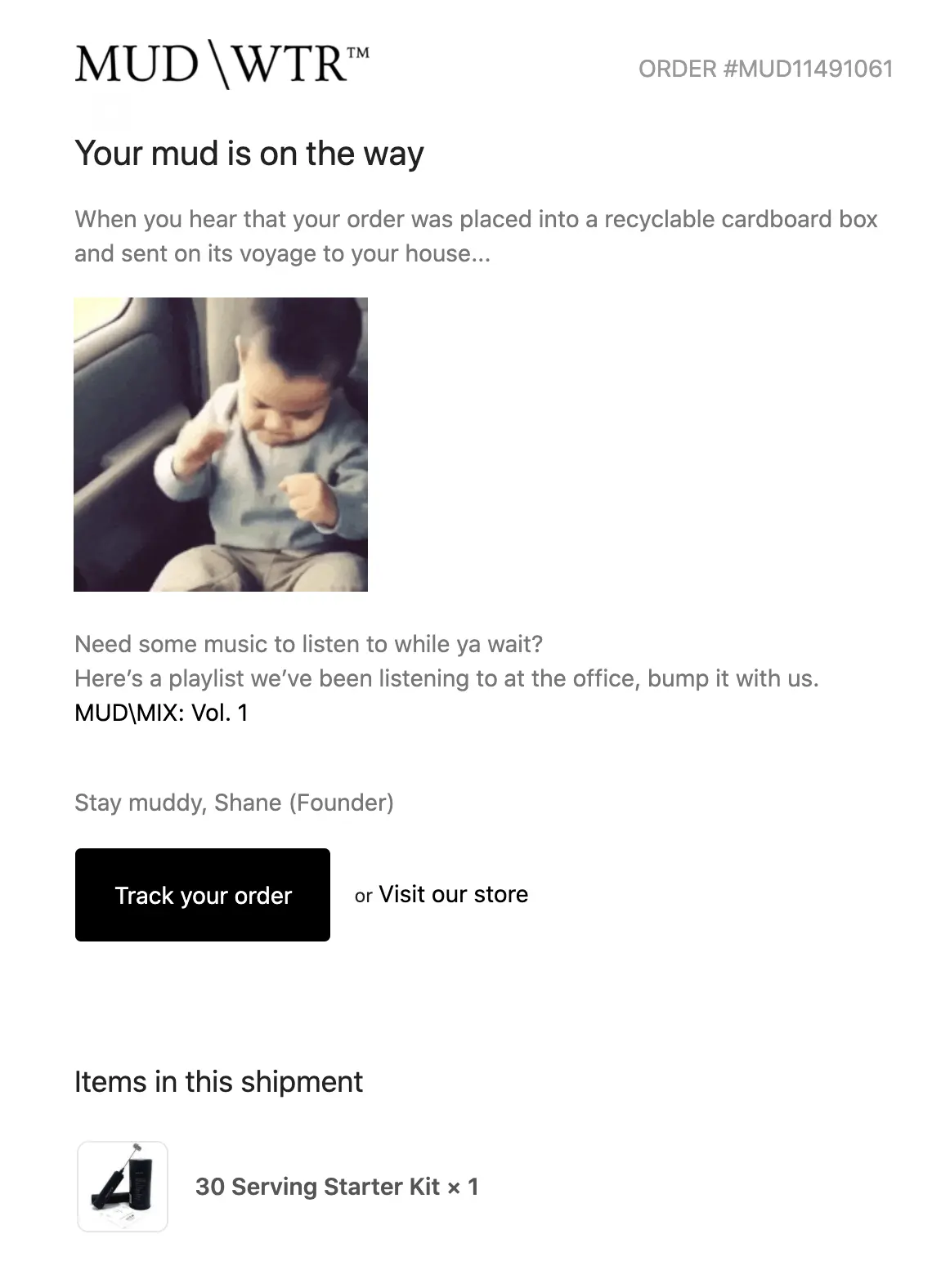
(From MUD/WTR)
Shipping update emails get sent out automatically to people when their order has shipped off and how they can keep track of its location.
These emails work great because they provide a sense of great relief to your customers.
Rather than constantly think what’s going on with their order, you’re giving them an opportunity to relax and go focus on other things in their lives.
And of course (once their shipment arrives), you can have another email fire off automatically to bring a sense of closure to the transaction and also use it as an opportunity to place other offers.
After The Sale Emails
After the sale emails are automation emails that aim to get customers to make their follow-up purchases with your brand.
Emails that fall into this category include:
- Onboarding Emails
- Review Gathering Emails
- Referral Campaign Emails
- Cross-Sell & Upsell Emails
- Win-Back Emails
- VIP Emails
- Anniversary Emails
- Trial-To-Continuity Emails
- Cancelled Subscription Emails
Onboarding Emails
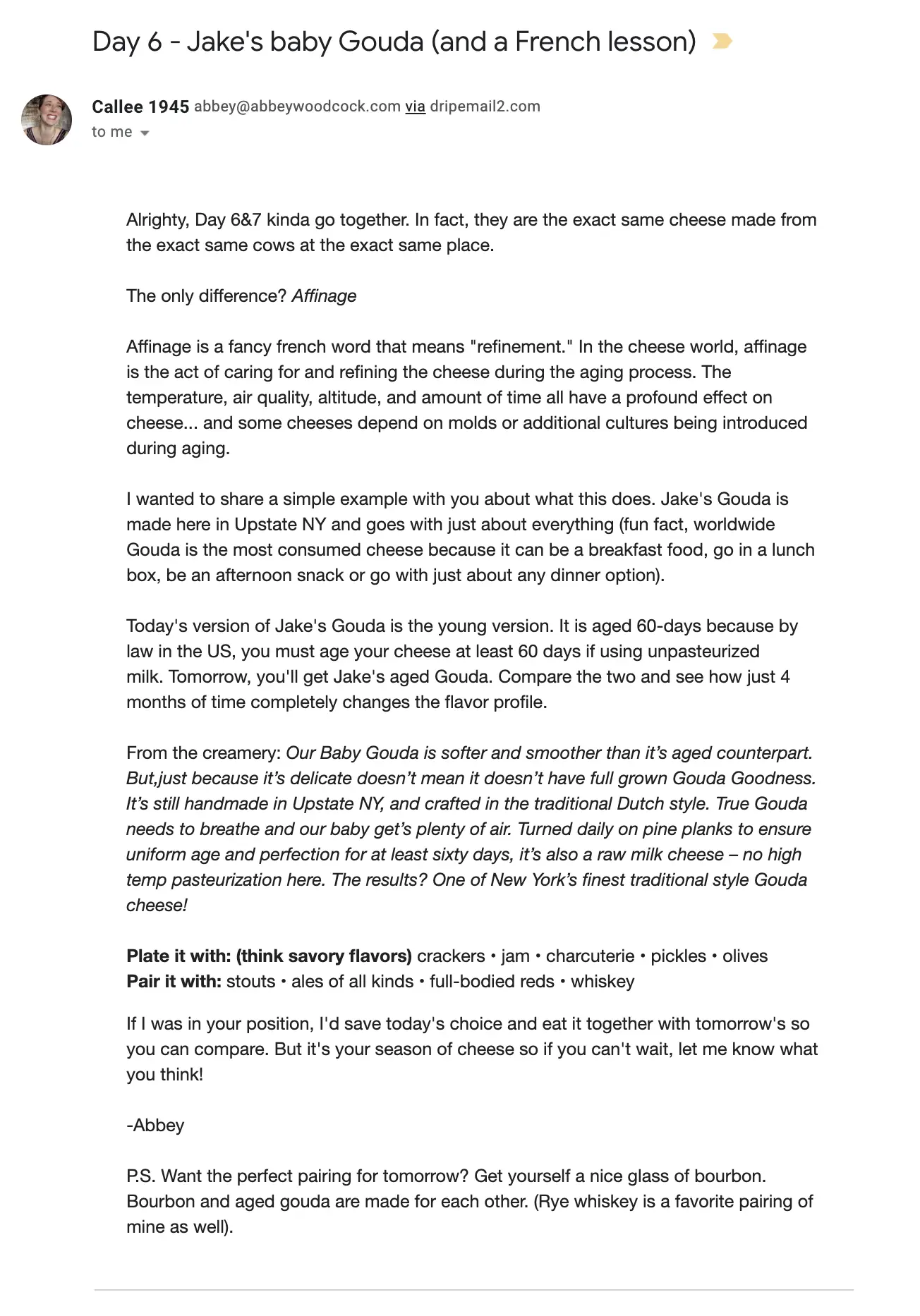
(From Callee 1945)
Onboarding emails get sent out to people automatically when they receive your product and help instruct them on how to use it properly.
It’s always a good idea to provide instructions to your customers to ensure they’re experiencing your products as best as possible (so they rave about it with reviews and recommending it to others).
Of course, it doesn’t have to necessarily be instructions. It can just be ideas and suggestions.
For example, if you’re selling wines, you could also recommend pairing it with certain cheeses and chocolates.
And if you happen to also sell those products… well, you get the idea.
For this automation, you only really need one onboarding email written and loaded up.
Review Gathering Emails
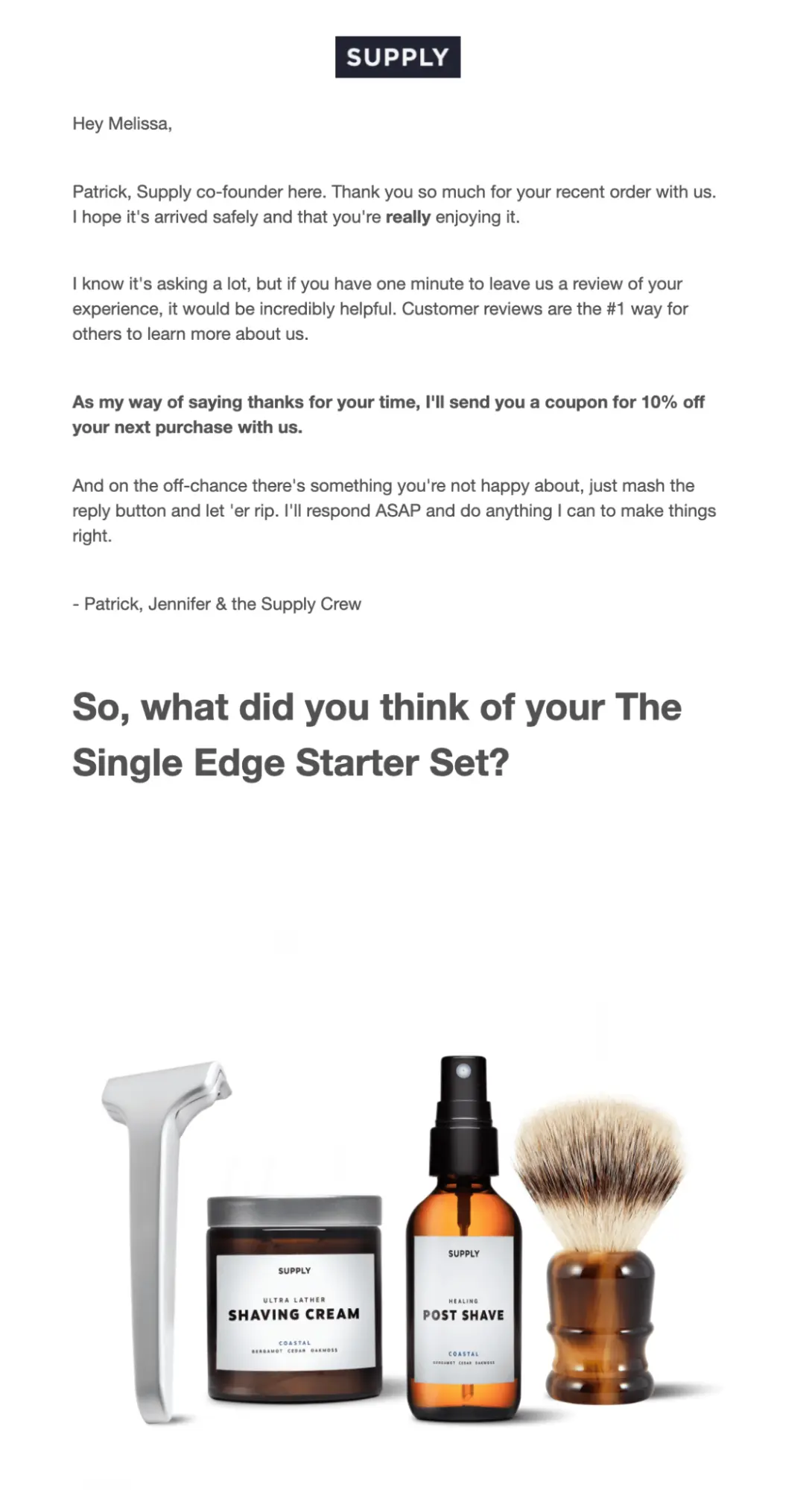
(From Supply)
Review gathering emails get sent out to people automatically when enough time has passed for them to have used and enjoyed your product and asks them to share their experience in the form of an online review.
A great way to encourage them to share their review is to provide an incentive with a deadline (maybe a discount or a $ amount off their next purchase).
The beauty of this is that not only will you get a positive review you can showcase in your marketing, you’ll also most likely get a second purchase pretty soon!
For this automation, you’ll want to include anywhere between 2 – 3 emails.
Referral Program Emails
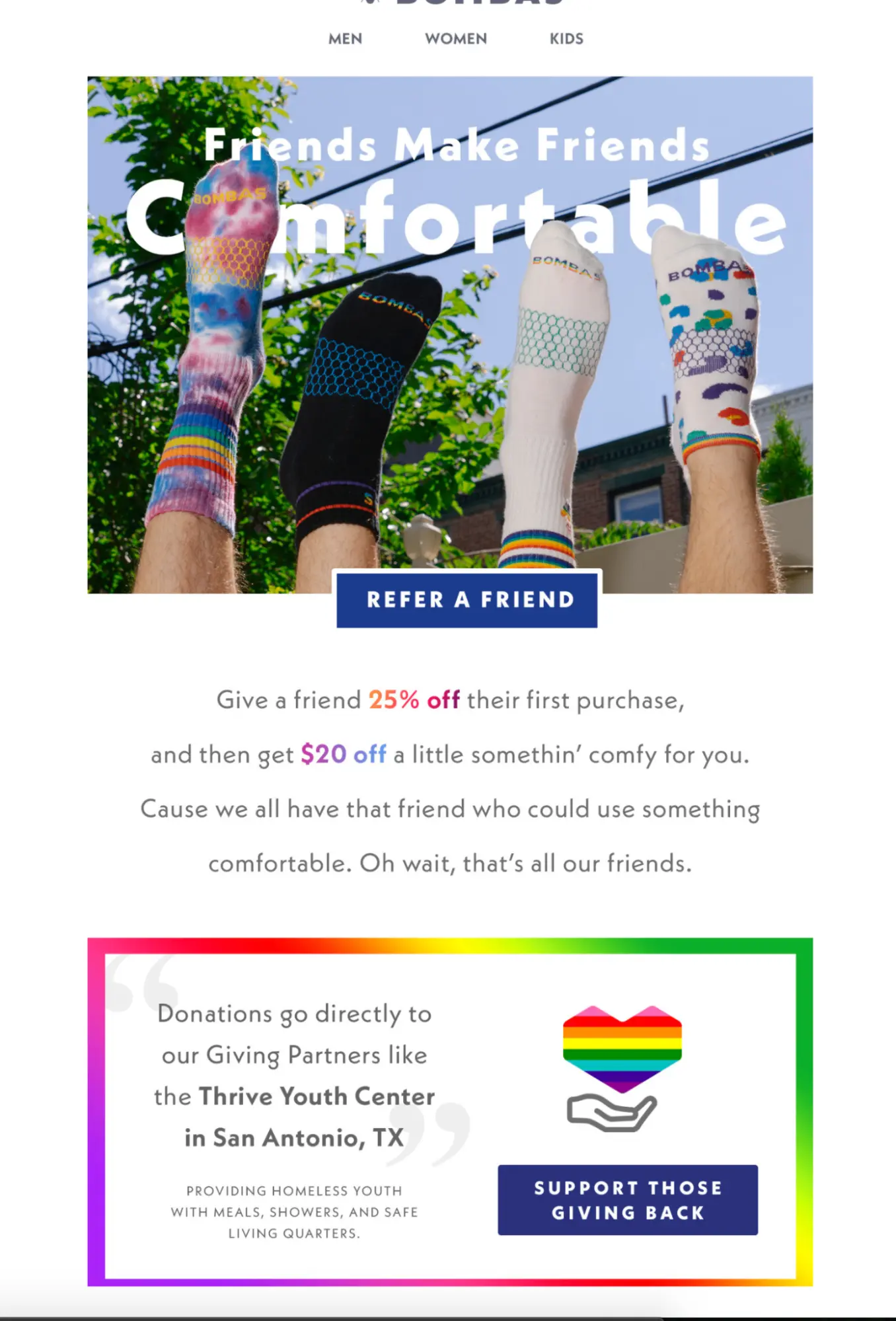
(From Bombas)
Referral program emails get sent out to people automatically after they’ve left a positive review and asks them to refer others to try out your offers, as well.
One of the reasons this works well is based on the principle of congruence and consistency (which Robert Cialdini discusses in his book Influence and Pre-suasion).
The idea is that if the person just raved about how awesome your product is…
If you ask them to rave about it to their friends amd family, there’s a high chance they will. Because they want to remain consistent with the kind of person they believe themselves to be.
People generally prefer when their self-image remains consistent.
And so they’ll behave in a way to ensure it does.
Knowing this, you can use the opportunity to ask them to rave about your products to their loved ones and offer them an incentive for each referral they send your way.
This’ll generate a lot of word of mouth for your brand and get you new sales and customers, as well.
For this automation, it’s best to have three emails written and loaded up.
Cross-Sell & Upsell Emails
Cross-sell & upsell emails get sent out to people automatically when it’s predicted they’ll be ready to make their next purchase.
Especially if you’re selling a consumable (like coffee or supplements), your customer data can show you when someone is likely to run out and buy again.
It’s not an exact science, but you can basically automate emails to send when the time comes to upsell them on more of the product or cross-sell products that compliment their main purchase.
You can even sell them on an auto-refill program that automatically places the order for them (and you).
For this automation, it’s best to have 3 emails written and loaded up.
Win-Back Emails
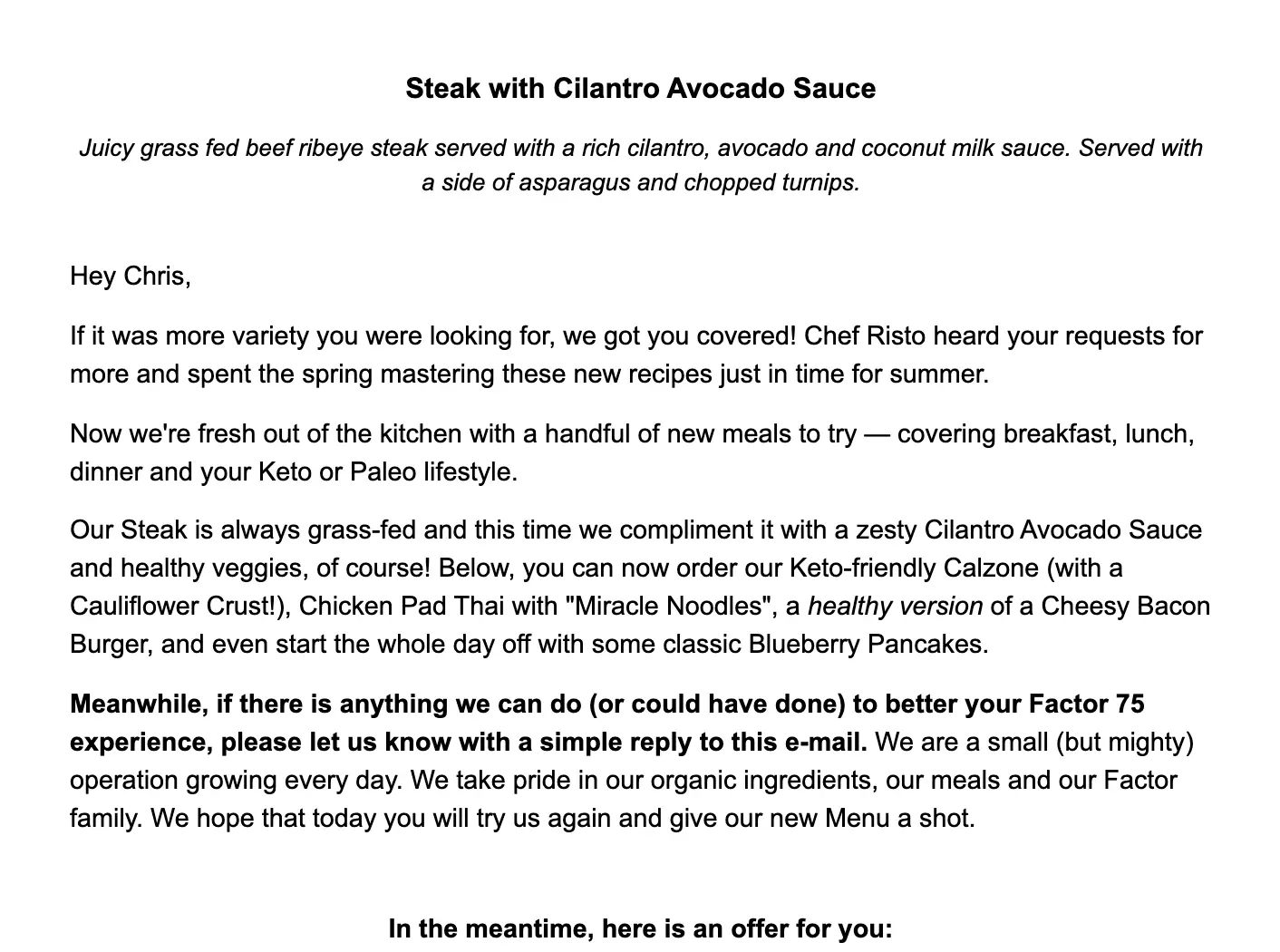
(From Factor 75)
Win-back emails get sent out automatically to people after a certain number of days has passed since they made their last purchase with you and acts as a way to get them back to being a regular customer again.
It’s a last-ditch effort.
Either the person doesn’t want to buy from your brand anymore or they’ll come back for another round.
Which is why for this sequence, you’ll want to set up 3 emails.
Each one should send off in 30, 60 or 90 days (or whatever makes the most sense for what you’re selling).
Since you really want to pull them back in, you’ll want to use “escalating incentives” with each follow-up email.
For example, the first email might offer them 10% off… with the second and third emails offering them 15% and 20% off respectively.
VIP Emails
VIP emails get sent out automatically to people after they’ve bought from your brand a certain number of times and acts as a way to encourage that behavior with some sort of reward.
In some ways, this is the opposite to the Win-Back emails.
If someone’s buying a lot from you, you definitely don’t want them leaving.
So you want to make sure you show them that you recognize and appreciate them as a valued customer.
For example, maybe the person has spend over $1,000 with your brand,
You can celebrate this by sending them an email that gives them a gift, a bonus, some store credit, an upgrade… or anything else that makes sense depending on what you’re selling.
By rewarding positive behavior, your best buyers will buy even more often from you.
For this automation, it’s best to have 3 emails written and loaded up.
Anniversary Emails
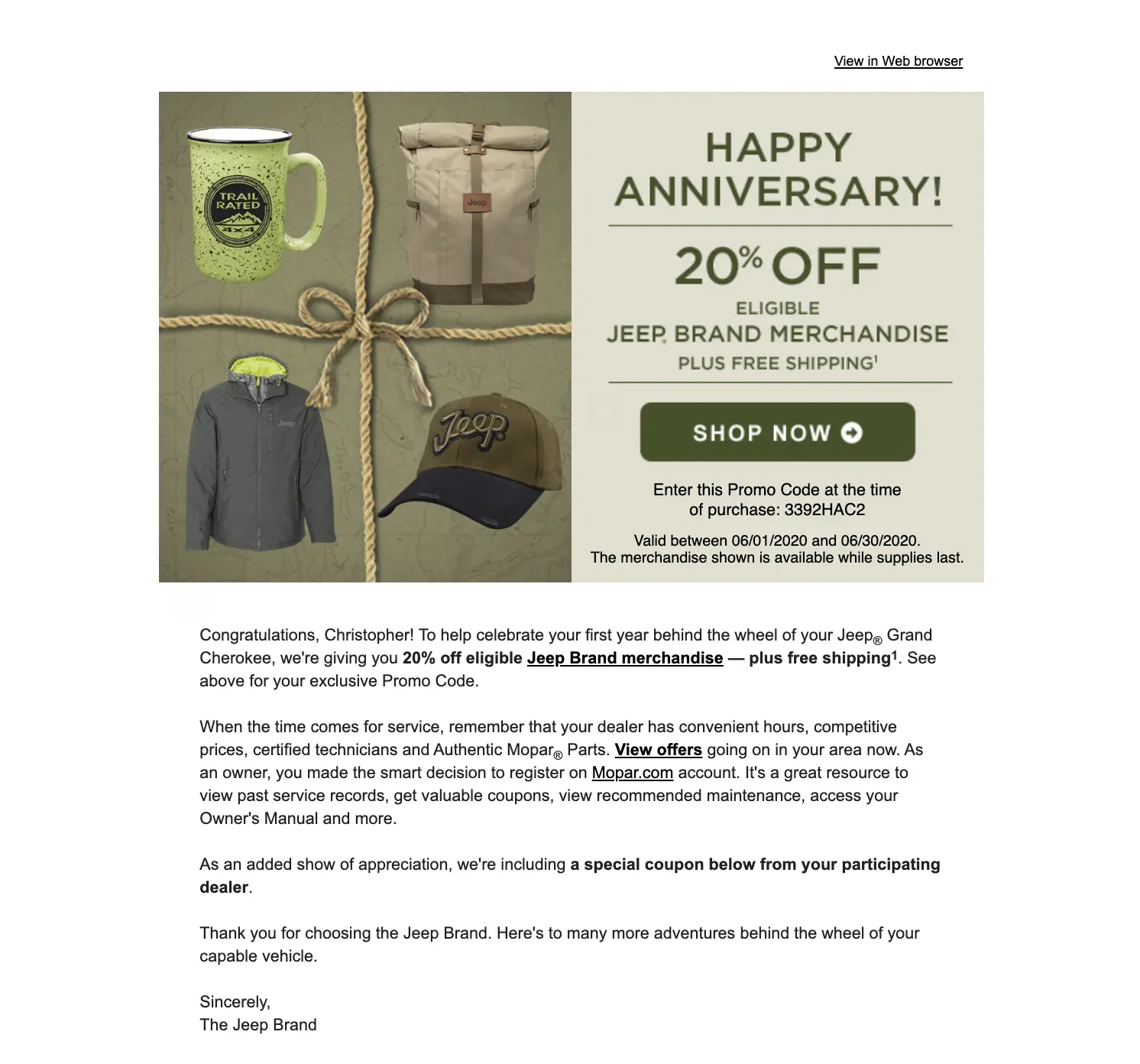
(From Jeep)
Anniversary emails get sent out to people automatically when it’s been a year since an important date has passed and celebrates the occasion by giving your customer a small gift they can use to buy from you.
There’s many anniversaries you can celebrate.
One that works great is the first-purchase anniversary.
This email sends out exactly one year after someone makes their first purchase and provides them either with store credit or discount they can use by a certain deadline.
Or you can just make it all about them by doing a birthday email instead.
Same idea, but this time it’s celebrating their birthday (and you can keep that going for every year).
For this automation, you only really need one email written and loaded up to send off once a year.
Trial-To-Continuity Emails
Trial-to-continuity emails get sent out to people automatically who are trying out one of your offers and gets them to upgrade towards a subscription.
You can’t expect people to upgrade on their own. That’s why you need to follow up with them until they join.
For these emails, you can offer an incentive with a deadline for them to sign up for a certain period of time.
Say you’re selling a coffee membership. You can give them an exclusive discount that gets them significant savings if they commit to 12 months upfront.
For this automation, it’s best to have 3 emails written and loaded up.
Cancelled Subscription Emails
Cancelled subscription emails get sent out to people automatically who cancel or downgrade their subscriptions and confirms the cancellation while trying to suggest ride-along offers.
When someone cancels or downgrades their subscription, it doesn’t necessarily mean they don’t want to buy from your brand anymore.
It simply means the offer wasn’t a good fit for their needs. If that’s the case, you can try to help them find an offer that would work better for them via suggestions.
This email works best by respecting the person’s decision to cancel or downgrade. Really, this email should act as a lending hand in helping them find a better solution.
For example, if someone cancels their subscription of fish oil, it may be because they’d rather get krill oil.
With these emails, you can offer an incentive with a deadline for them to sign up for a certain period of time.
Say you’re selling something like a coffee membership. You can give them an exclusive discount that gets them significant savings if they commit to 12 months upfront.
For this automation, having one email written and loaded is up fine.
Broadcast Emails
Broadcast emails are emails that are scheduled to be sent to people on your list at a certain given date and time.
These are usually written ahead of time and tested before scheduling out for broadcast.
On top of setting up automations, you should be sending out these kinds of emails as well to really have a proper frequency of emails being sent out to your subscribers.
For ecommerce brands, there are mainly 3 types of broadcast emails to consider:
- Belief Shifting Emails
- Announcement Emails
- Customer Success Emails
Before we get into that though, let’s take a quick look at how ecommerce brands use segmentation as a strategy for generating more sales.
The Power of Segmenting Subscribers
Segmentation is when people on your email list get tagged and placed in a certain category based on their user behavior.
And it is incredibly powerful for one simple reason:
With email segmentation, you have the power of sending the right message for the right offer to the right person at the right time.
For example, if you’re selling wine, you may want to segment your people based on whether they buy red wines or white whines more frequently.
Doing this would make it easier for you to promote new bottles of white wine to the right crowd without needlessly having to annoy anyone who wouldn’t be as interested.
Without segmentation, email marketing would just be a whole lot like direct mail marketing.
You’d be “blasting” everyone on your list with one message and hoping it gets some sort of reaction.
Thankfully, segmentation DOES exist, which allows for greater precision (meaning more sales and higher profit margins).
With email’s built-in segmentation tools, you gain WAY more insights on how each person on your list is behaving to your marketing efforts.
Segmentation Allows You To Craft New Offers
You can use your email list to validate offers before creating them.
It’s as simple as sending out an email asking your readers if they’re interested about you creating an offer that solves a specific problem they have.
If you get enough responses, it validates the pursuit of developing the offer since you know you’ve got people who’d buy once it’s ready.
And if not, you know to steer away and focus elsewhere.
It’s win-win, either way.
How To Segment Your Email List
In the ecommerce email marketing space, you can generally segment people based on:
- How they’re joining your list (using different incentives & forms)
- How much they’re spending with you (and how often)
- Which products they’re buying from you
- Which emails they’re opening, clicking and responding to
Belief Shifting Emails
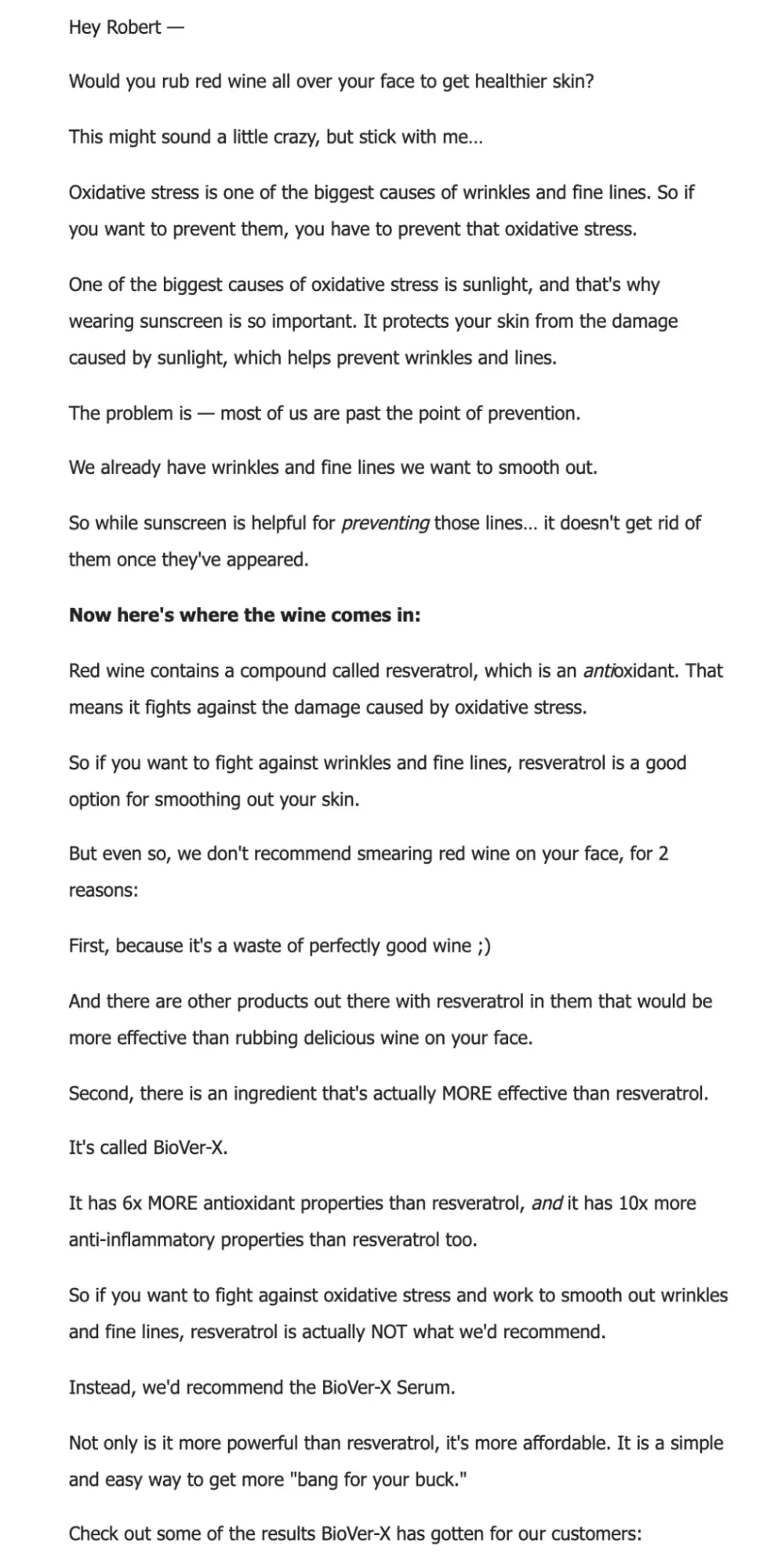
(From K & K Skin Products)
Belief shifting emails are emails that try to get readers to consider a new belief that will empower them as individuals and enrich their lives permanently.
Ry Schwartz from Copyhackers puts it in these words:
“We hard sell belief, commitment, decisiveness and outcomes so that we can soft sell the product that delivers it.”
Like all humans, your readers hold certain beliefs about themselves and the world.
Although it’s very possible some of their beliefs are holding them back on achieving and living their best lives yet.
When you’re emailing someone on your list, you have an opportunity to help them rethink some of their limiting beliefs.
Belief shifting emails can help your readers come up with better beliefs to hold by having them reconsider:
- The outcome they’re trying to achieve
- Their past failures (and why it’s not their fault)
- Their own abilities to make things better
- The most common methods of trying to solve their problems (as seen in the industry you’re in)
- You (as the person) who is writing to them and your role in helping them
When done right, a belief shifting email can restore your reader’s hope in themselves and achieving their goals. And if they’re willing to bet on their success, they’re more likely to take action and buy your products (if they truly believe it can help them become the person they wish to be).
Announcement Emails
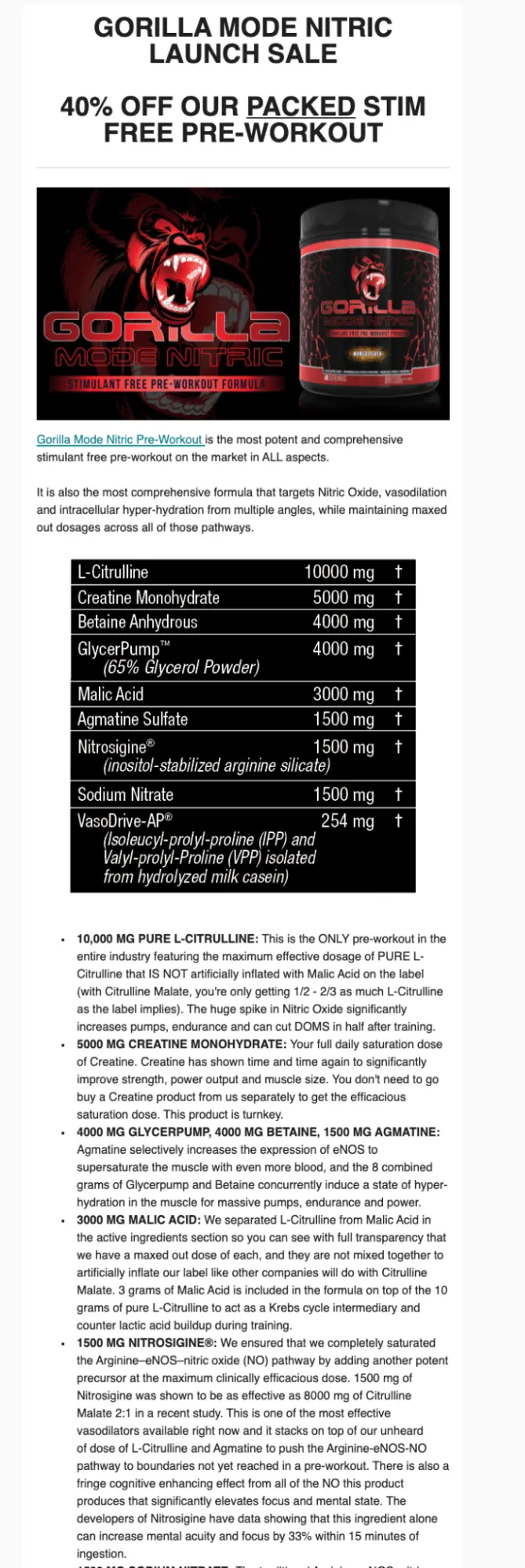
(From Gorilla Mind)
Announcement emails are where you just announce something cool and exciting that’s happening with your business.
It could be the release of a new product or an upcoming event.
In a nutshell, it’s just a “heads up” type of email.
When businesses first started doing email marketing, it was practically all announcement emails.
While they’ve still got a place even now, it’s important not to send these types of emails exclusively.
Good ecommerce email marketing requires a balance between sales-focused emails and emails where selling is secondary.
Customer Success Emails
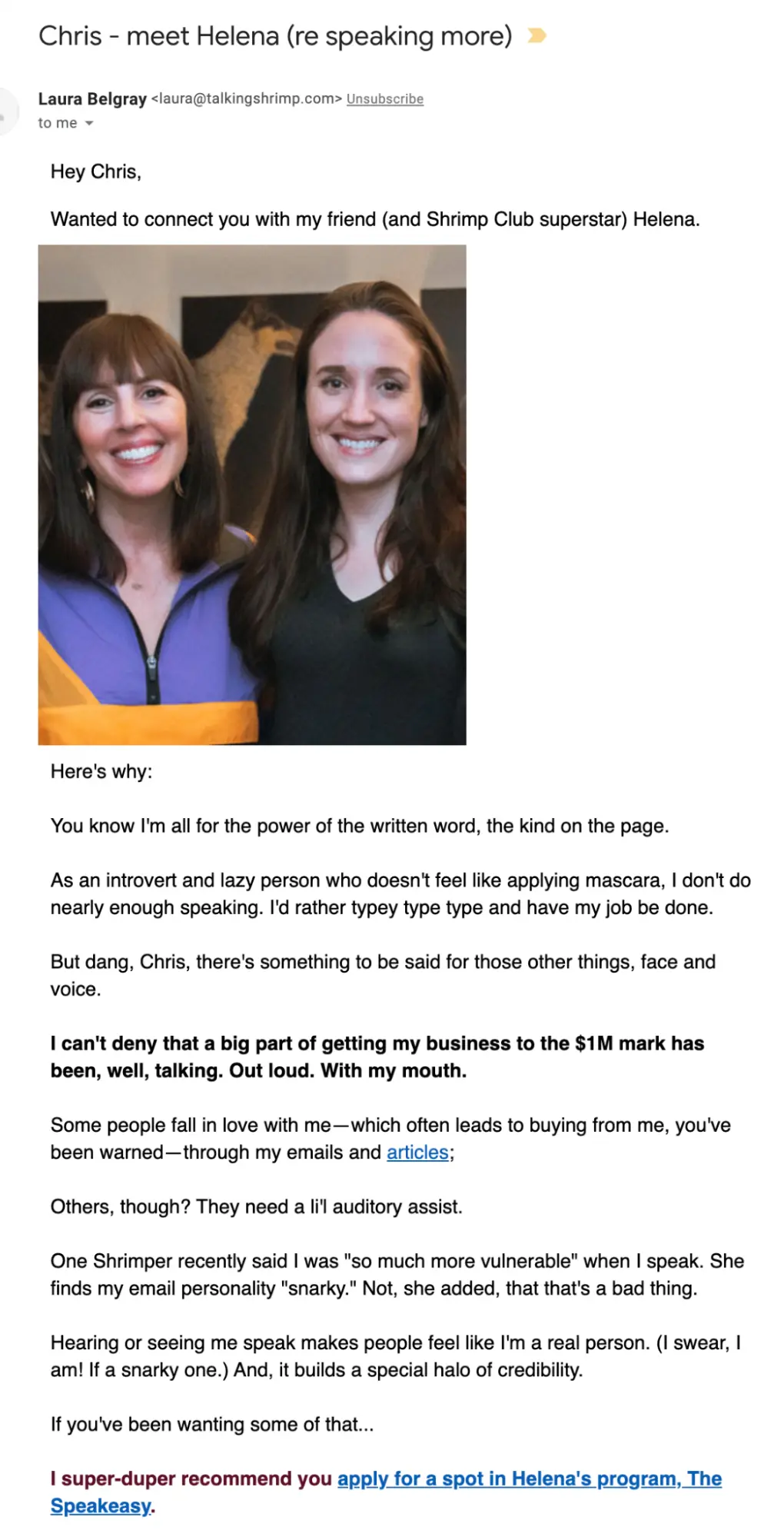
(From Talking Shrimp)
Customer success emails are emails that celebrate recent wins from some of your business’ biggest fans.
After all, it’s pretty powerful when you can show the effectiveness of your offers through the actual voice of your customers.
These emails usually feature the story of the customer… along with a testimonial they shared about their experience using your products.
The beauty of this is that it helps convince others to buy your products (without you having to do any of the heavy-lifting).
Especially if it’s someone who’s been on the fence about buying from you… seeing others find success repeatedly across your emails will slowly start getting them to take action with their own lives.
Launch Emails
Launch emails are emails used as part of a promo campaign for when your business is launching something new and you want your subscribers to get excited and ready to buy when it all goes live.
It could be the launch of a new product or a special event with exclusive pricing.
Whatever it is, you want to get people excited and eagerly buying until the final hour.
To set up a proper launch email campaign, you’ll want to make sure you have these 3 types of emails written and loaded up:
- Pre-Sale Emails
- Open Sale Emails
- Closing Sale Emails
Pre-Sale Emails
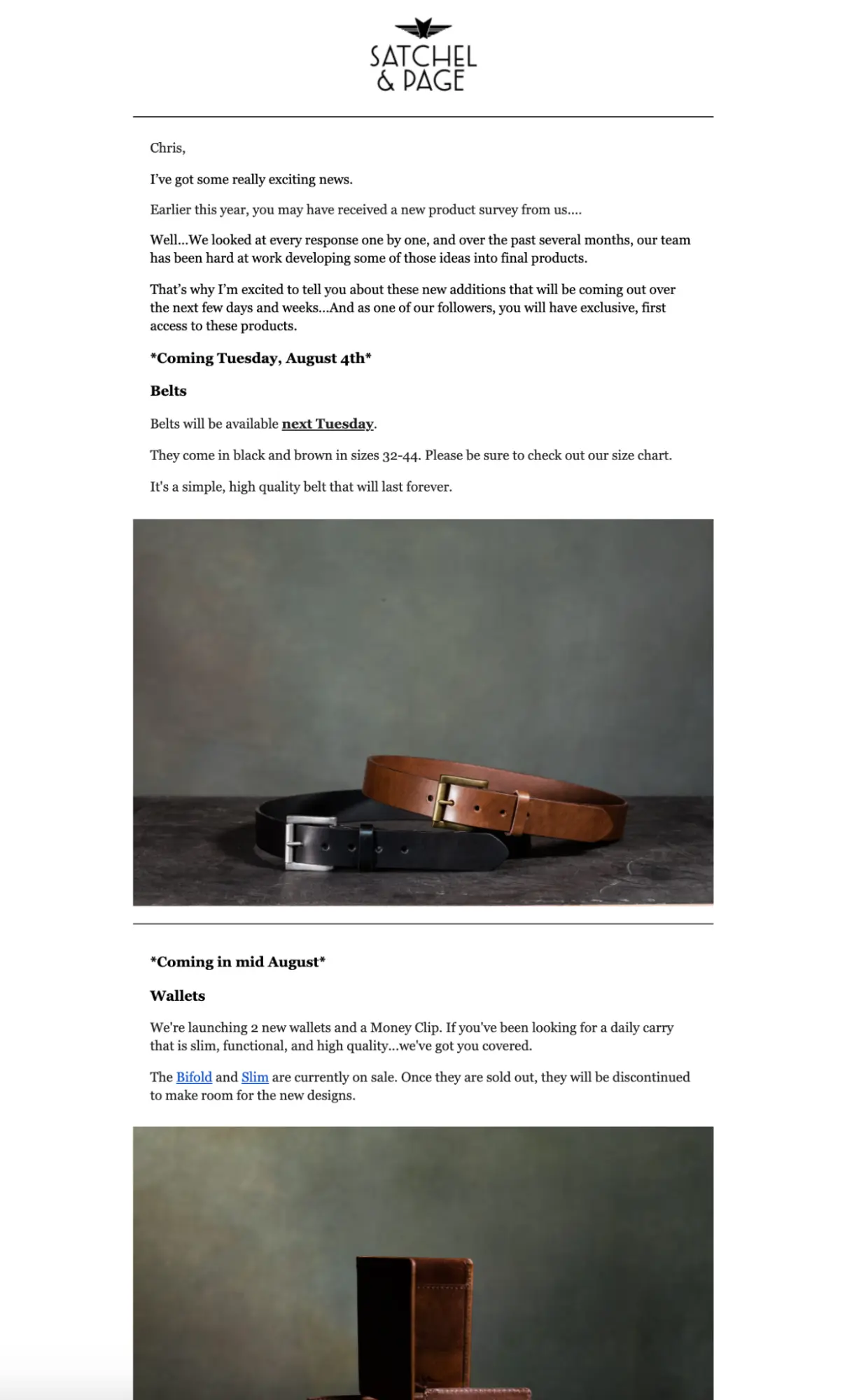
(From Satchel & Page)
Presale emails are a series of emails spread out across a few days leading up to the launch and set the stage by warming up your audience and getting them excited to buy.
This part of the launch campaign is arguably the most important.
Because if done poorly, you can easily end up launching to crickets.
So a proper build-up is ABSOLUTELY necessary for a launch to be successful.
At a minimum, you want to at least have two emails for this part of the launch email campaign.
What works best is teasing the launch and giving people a call-to-action to get on an early bird list by clicking on a link (so you can tag them into a segment).
Open Sale Emails
Open sale emails are a series of emails that announce the launch going live and maintain momentum until it’s almost over.
This is basically when the “cart is open”.
Depending on what you’re launching, there’s a number of ways to engage with the people on your early bird list that you recruited during the pre-sale part of the campaign.
For example, if you’re selling a new product and inventory is running low, it’d be a great opportunity to let people know so they don’t miss out.
If you’ve been getting lots of questions during the launch, you could send out an email where you answer all those questions for anyone else who might be wondering the same things.
Or if you’re launching an event sale, you can use reviews from the past year to show this year’s crowd what they’re in for.
For the most part, it’s okay to be a bit more aggressive with the sales messaging in these types of emails (since the people in your early bird list signed up for it and want to hear the details).
There’s no perfect number of emails for this part of the launch campaign.
At a minimum, you should at least have two emails. One that announces the launch has gone live and one that keeps the momentum going.
But that’s just the minimum. You’ll definitely want more emails in this phase for your launch to succeed.
Closing Sale Emails
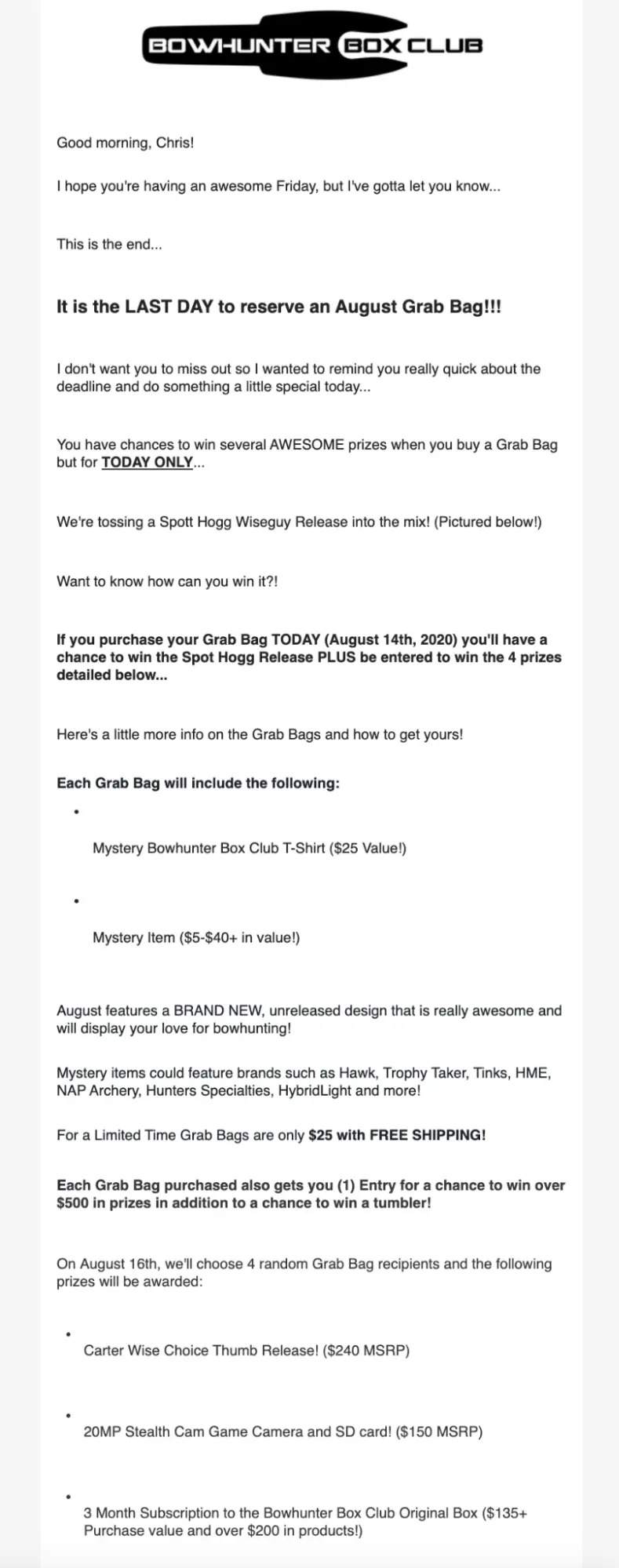
(From Bowhunter Box Club)
Closing sale emails are a series of emails that announce the launch is ending soon so that you can scoop up last minute sales while there’s still a chance.
You only need about 2 – 3 emails for this part.
One can be set up during the morning of the last day, another an hour before the deadline and the last one at 15 minutes before the deadline.
These emails are mainly just reminders to shake up anyone who hasn’t bought yet.
You can use these emails to quickly summarize all the facts of what you’re selling.
At a minimum, that means talking about what they’re getting, how much it costs, and deadlines to act.
Maximizing Deliverability For Your Ecommerce Email Marketing
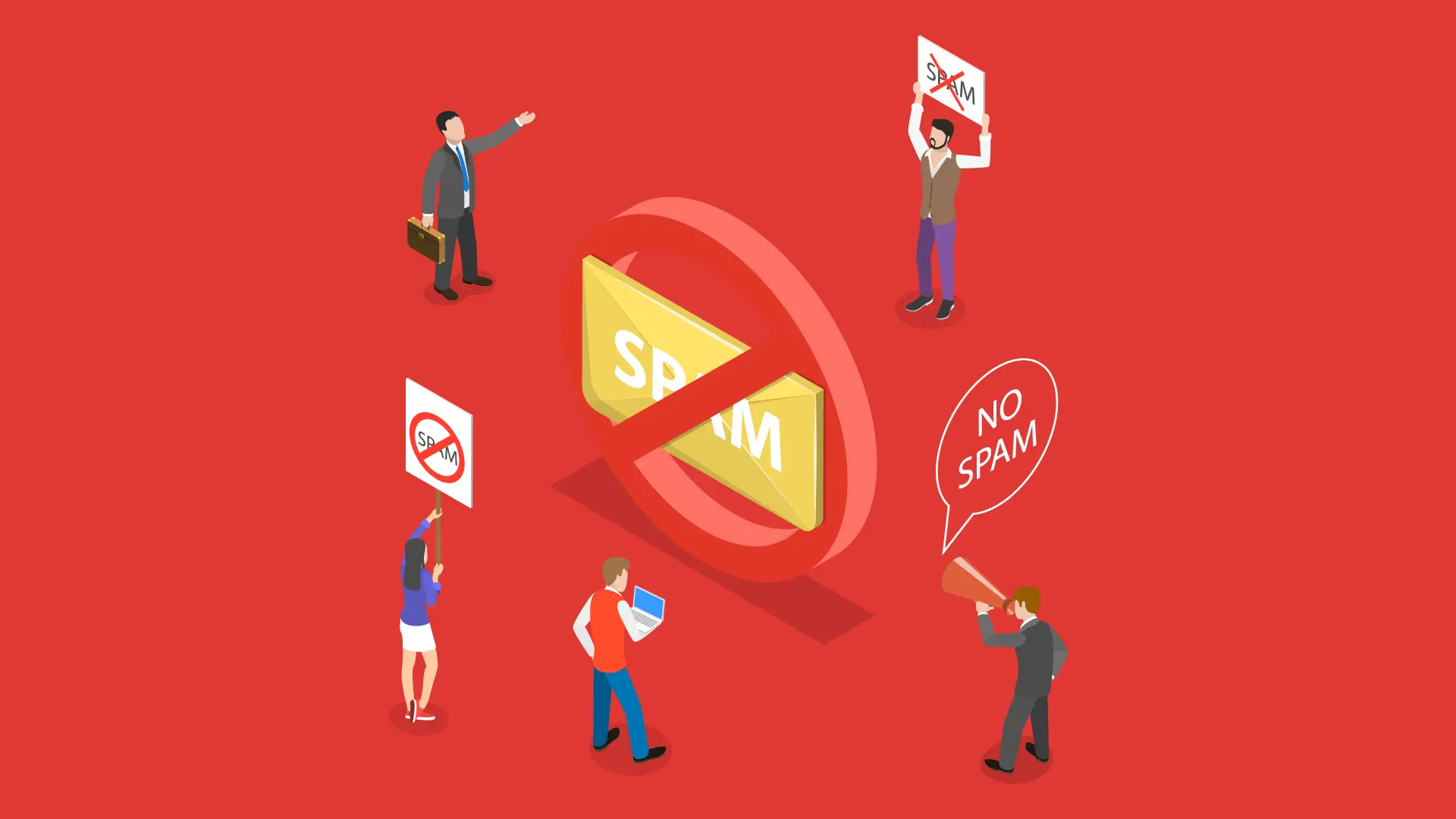
I only really recommend doing the following two things:
- Writing plain-text emails
- Scrubbing your list regularly
Writing Plain-Text Emails
My key philosophy for ecommerce email marketing can be easily summarized as:
EMAIL COPY > EMAIL DESIGN
If you ask me, the best emails are written… not designed.
As you’ll see in one of my rules for writing and sending emails in the immediate section below, I always try to email the person as a person (not as a brand or a corporation).
And well… an actual person wouldn’t spend time designing a pretty poster email. They would just write to whoever they’re writing to.
It also just so happens that when you’re only sending out plain-text emails, your stuff isn’t ending up in the Promotions tab or Spam folder.
So when it comes maximizing deliverability, using plain-text emails works great for me and all my clients here at the agency.
And look, I get as an ecommerce brand you’ll still want to send out the “pretty poster” emails. That’s perfectly okay.
Especially if you’re selling fashion or apparel items, you’ll definitely need to lean into the visuals to get the sale with your products.
But that doesn’t mean you should underestimate the power of great copy to sell your products.
Let me show you what I mean…
How To Sell Your Products Without Using Any Visuals
There’s this company that’s been around for a few decades called J. Peterman.
They’ve built a nine-figure apparel empire on the strength of their copy and marketing chops.
Have you ever seen one of their product descriptions?
Take a look at this…
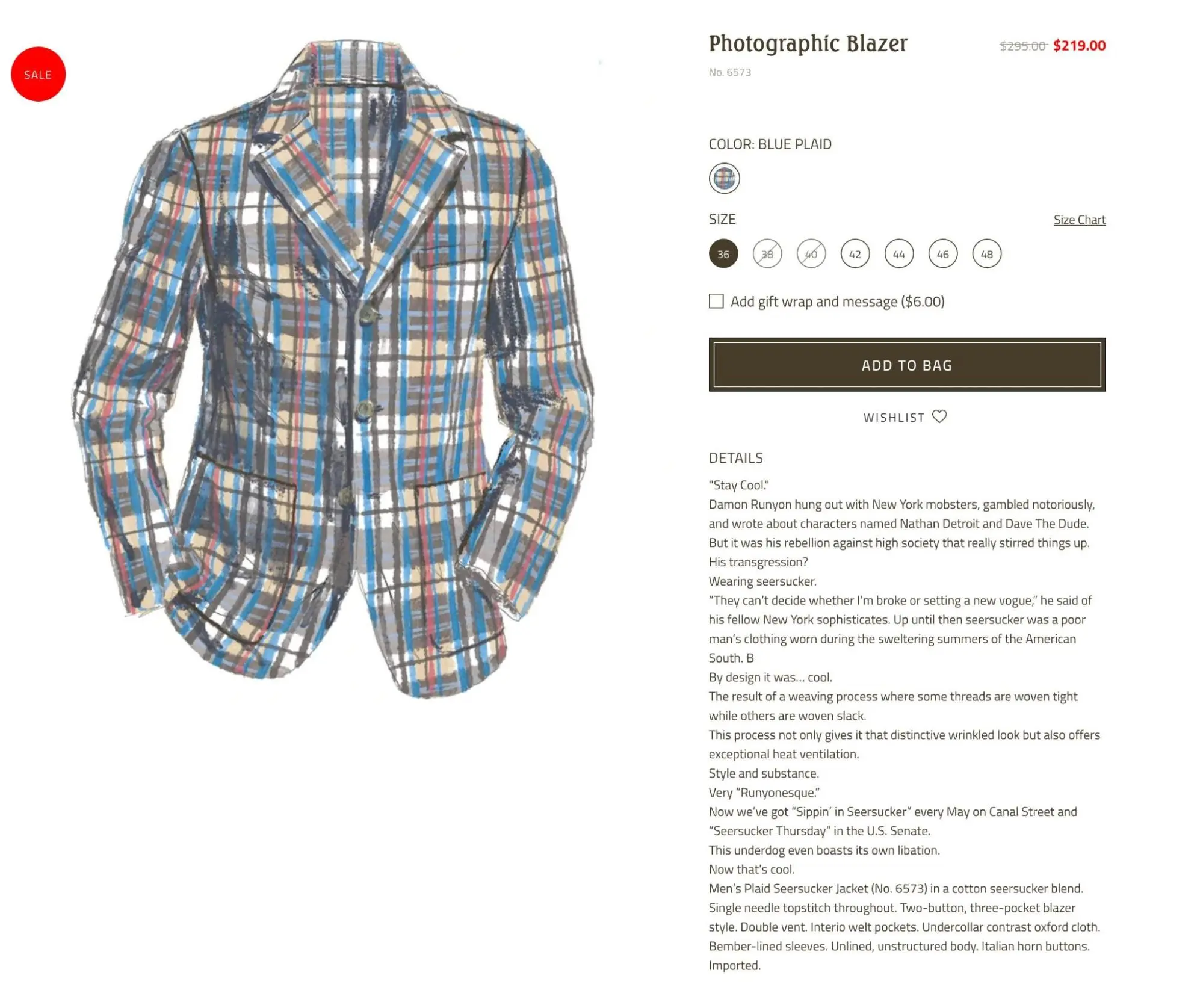
Here’s the product description from the image above:
“Stay Cool.”
Damon Runyon hung out with New York mobsters, gambled notoriously, and wrote about characters named Nathan Detroit and Dave The Dude.
But it was his rebellion against high society that really stirred things up.
His transgression?
Wearing seersucker.
“They can’t decide whether I’m broke or setting a new vogue,” he said of his fellow New York sophisticates. Up until then seersucker was a poor man’s clothing worn during the sweltering summers of the American South. B
By design it was… cool.
The result of a weaving process where some threads are woven tight while others are woven slack.
This process not only gives it that distinctive wrinkled look but also offers exceptional heat ventilation.
Style and substance.
Very “Runyonesque.”
Now we’ve got “Sippin’ in Seersucker” every May on Canal Street and “Seersucker Thursday” in the U.S. Senate.
This underdog even boasts its own libation.
Now that’s cool.
Men’s Plaid Seersucker Jacket (No. 6573) in a cotton seersucker blend. Single needle topstitch throughout. Two-button, three-pocket blazer style. Double vent. Interio welt pockets. Undercollar contrast oxford cloth. Bember-lined sleeves. Unlined, unstructured body. Italian horn buttons. Imported.
—
Now, when you read that copy… what do you feel?
Do you feel like you’ve been swept away on an adventure?
Of course you do.
Know WHY you feel that way?
It was the words… NOT the pictures that aroused these feelings.
Let’s take a look at another example…
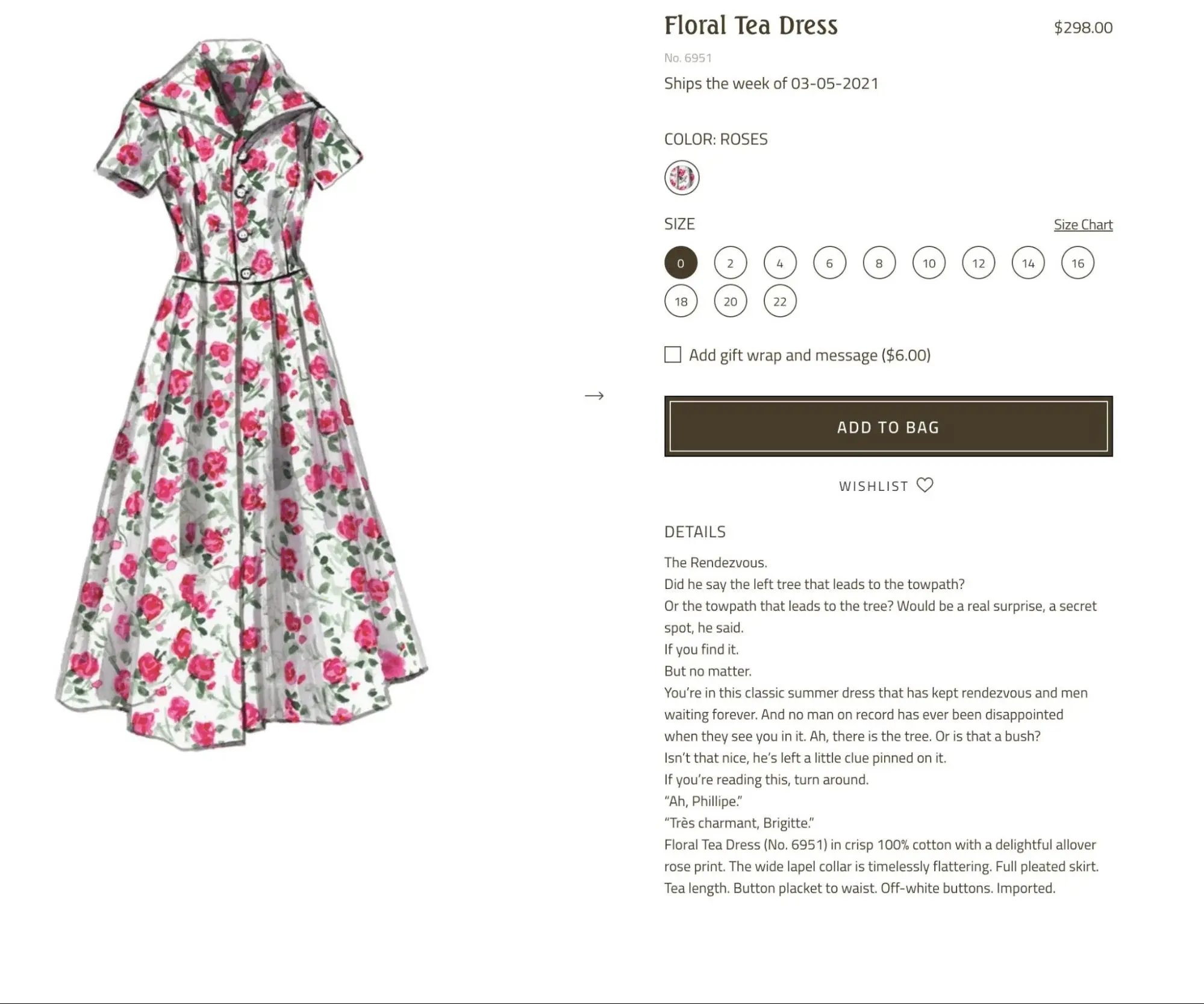
Here’s the description for this one:
The Rendezvous.
Did he say the left tree that leads to the towpath?
Or the towpath that leads to the tree? Would be a real surprise, a secret spot, he said.
If you find it.
But no matter.
You’re in this classic summer dress that has kept rendezvous and men waiting forever. And no man on record has ever been disappointed when they see you in it. Ah, there is the tree. Or is that a bush?
Isn’t that nice, he’s left a little clue pinned on it.
If you’re reading this, turn around.
“Ah, Phillipe.”
“Très charmant, Brigitte.”
Floral Tea Dress (No. 6951) in crisp 100% cotton with a delightful allover rose print. The wide lapel collar is timelessly flattering. Full pleated skirt. Tea length. Button placket to waist. Off-white buttons. Imported.
You’ve gotta hand it to the copywriters working at J. Peterman.
They are DAMN GOOD at what they do.
And that’s the thing:
It’s easy to just slap an image in an email and call it a day like everyone else does.
But the way you build a brand that transcends your industry and builds customers for life is by whisking them away on an adventure with great copy.
And it’s really not that hard.
In fact, I’ll show you how we write emails here at my agency for clients after we go over how to scrub your email list properly.
Scrubbing Your List Regularly
If you’re doing what you’re supposed to be doing with your ecommerce email marketing, you’re inevitably going to end up with a huge email list.
Which means you’re also going to end up with a lot of “inactive subscribers”.
Generally, I separate this group of subscribers into two categories:
- The Old Flame
- The One Night Stand
The Old Flame
The Old Flame is an inactive subscriber who used to engage and buy from your emails, but has gone cold for a while.
Instead, you want to set up an automation that fires off if they haven’t made a purchase from you after a certain number of days.
The One Night Stand
The One Night Stand is an inactive subscriber who initially signed up to your list and just straight-up ghosted you afterwards.
They MAY have opened a few of your emails in the beginning.
But it’s months since they opened anything you’ve sent them.
Instead, they’re just taking up space on your list and costing you money.
Now, I’m not saying they’re bad people.
But here’s what you need to remember:
These people are going to keep getting your emails and will continue to not open ANY of them.
The Still Alive automation is designed specifically to try and engage with these people before you scrub them off your list.
How We Write Ecommerce Emails Here At Our Agency
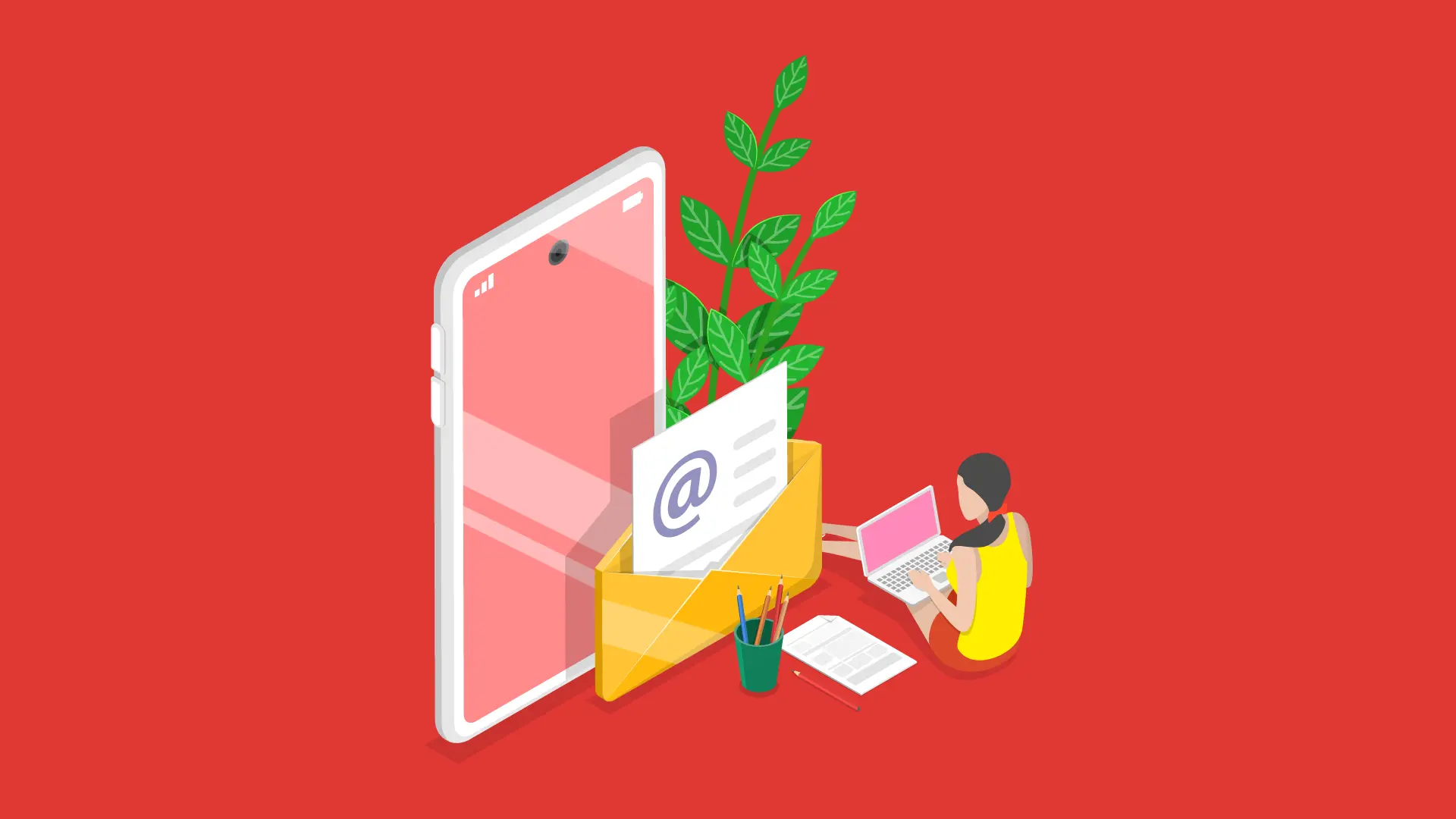
It’s one thing to send emails. But it’s another to write them well.
Granted, there’s a lot of templates and examples that can help you get started…
But if you want people opening your emails and buying from them at higher numbers, then you need to focus on improving the actual copy itself.
This is how I’ve helped my clients all get better performance with their email marketing.
Over the years, I’ve taken the time to try and boil it all down to a few rules that kept popping up no matter who I worked with:
- Use Human Interest Subject Lines
- Write From One Person… To One Person
- Tell Them A Story
- Pace, Then Lead
- Show, Don’t Tell
- Invoke A Specific Emotion With Your Writing
- Demonstrate & Dimensionalize
- Always Give Them A Call To Action
- Swap Generic Details For Specific Ones
- Punch It Up Before Sending
Use Human Interest Subject Lines
You won’t get people opening your emails if it looks and smells like another annoying marketing email from how the subject line is written.
Instead, write subject lines that feel like it’s coming from a friend… and that also generates intense curiosity.
For example:
“i really shouldn’t post on facebook at 7am…”
See how that feels like it’s from someone you’ve known since high school and draws you into opening up the email and finding out how they goofed?
Try experimenting with that approach and see what works best for your brand.
Also, never use clickbait subject lines to trick people into opening your emails.
Instead, write something that relates to the content inside.
Write From One Person... To One Person
People don’t buy from corporations or brands. They buy from other people.
Saying, “Hello everyone, I hope you’re all having a great day!” is weird.
(Unless it’s YouTube or Instagram, I guess.)
With emails, stick to “I and you” language.
After all, your ONE subscriber is reading the ONE email from you.
So you should always make it personal to that ONE person.
Tell Them A Story
People pay attention to stories.
Instead of just telling your reader something, draw them in with a story:
For example:
“I was having a chat with John in marketing the other day when your name came up. I realized you haven’t visited our store in a while, that’s why…”
… is a lot better than:
“Our systems show you haven’t visited our store in a while…”
Pace, Then Lead
Your copy should generally begin with your prospect’s problems and then take them by the hand and lead them to the outcomes they desire.
By pacing first, you’re empathizing with your reader and building a bond by showing them “you get it”.
You’re showing them that you’re on their team — no matter what.
Once they feel like you’ve got their back and they can trust you, then they’ll be much more receptive to anything else you’re telling them.
So always pace (by identifying their problem), then lead (to their desired outcome).
Show, Don't Tell
In storytelling, this is sometimes referred to as:
“Giving them 2 + 2, not 4.”
For example:
Saying, “The man was mad.”
… is nowhere near as powerful as, “steam was coming from Mr. Smith’s ears as he barreled down the hall.”
Not only is this a lot more visually vivid (which makes it more memorable), but it also lets your reader’s brain piece together the information and draw up their own conclusion (which is more satisfying to them than being spoon-fed the answer).
So don’t be afraid to paint the picture a little bit with some details.
Invoke A Specific Emotion With Your Writing
Before you start writing, you should be intentional about what you want your reader to feel when they’re reading your email.
You should be able to say, “I’m trying to make them laugh, cry, feel envy, etc…”
If you’re reading your email and the emotions you’re trying to elicit aren’t obvious, then rewrite it.
Good emails inspire the reader.
And to achieve that, you need to take them on a bit of an emotional rollercoaster.
It’s also why everyone loves movies.
Because by the end of a flick, you’ve felt a bunch of emotions. And that’s why you keep thinking about it and bringing it up in conversations years and years after.
Your emails can do the same for your reader.
So get clear on what emotions you want your reader to have felt by the time they’re done reading.
Demonstrate
Nothing crushes objections like a dramatic demonstration.
Tell a story that SHOWS how your customers are using your product to solve their problems. They should understand how it works, why it works, and why it’ll work for them.
For example, here’s some copy from a welcome sequence campaign we ran for a client in the sunglass niche:
“I wanted to share a recent review with you.
‘Do you know how you can just feel the quality of a pair of sunglasses? When you hold these they just feel expensive. And by expensive I mean like 4 to 5 [hundred] range. I’ve been a dedicated Prada eyewear person for a while. But these I have gotten way more compliments on in the last few days than I have ever gotten on my Prada or my Montblanc. Both of which were around the $400 range. I have the “Biker Black”. I am excited to get the Leopardo.’
– Gregory F.
I gotta tell you… getting these kinds of emails every day lights me up.
You see, Gregory’s not only got a pair of high-quality sunglasses that FEEL like they cost $500…
… he’s also got way more compliments than he has on his Pradas that cost him TEN TIMES as much as his Biker Blacks?”
See how that just crushes any objection a person might have about the quality of the sunglasses through the experience of another customer?
That’s how you demonstrate your product to the reader.
Dimensionalize
Get your readers to “think past the sale” and imagine what their life could look like AFTER they’ve experienced the benefit of your product.
For example, here’s some copy from a cart abandonment campaign we created for the same client as above:
“… I wanted to check that everything was OK?
Maybe you got distracted, daydreaming of how cool these would look on you as you sat on the balcony of your chateau, sipping the finest champagne on a warm summer’s evening, as you leaned back and gazed upon the magnificent French Alps…
… or maybe you got tagged in a Facebook post and had to go see what all the fuss was about.
Either way, your sunglasses are waiting for you right here…”
Notice how that makes you feel what it’s like to own the product?
That’s what dimensionalizing does.
It brings the experience of owning the product to LIFE for your reader.
Always Give Them A Call To Action
Every email should be treated as an opportunity to make the cash register ring.
So don’t EVER crap out on the pitch.
Be direct, give explicit directions and unpack all important details of the offer.
Don’t get your reader dressed up with nowhere to go… always direct them to the next action to take.
Punch It Up Before Sending
Before you hit send, always run your copy through a review process to make sure it’s as good as it can be.
Here’s a few ways to punch up your copy.
Run It Through The Hemingway Editor
The Hemingway Editor is the perfect tool for helping you catch all the wordy, wonky bits in your copy.
I use it all the time to tighten and polish up my writing before publishing.
Cut Your Word Count By 10%
Challenge yourself to trim down your writing and say the same thing in fewer words.
And as a fun exercise, imagine every word costs $100 to use (an idea I stole from Scott Adams).
Read It Out Loud
Read your email copy out loud. If it feels weird and unnatural… rewrite it so that it sounds more conversational and flows right.
Remember, you’re writing as a person… not a brand.
Ecommerce Email Marketing Examples To Help Inspire You
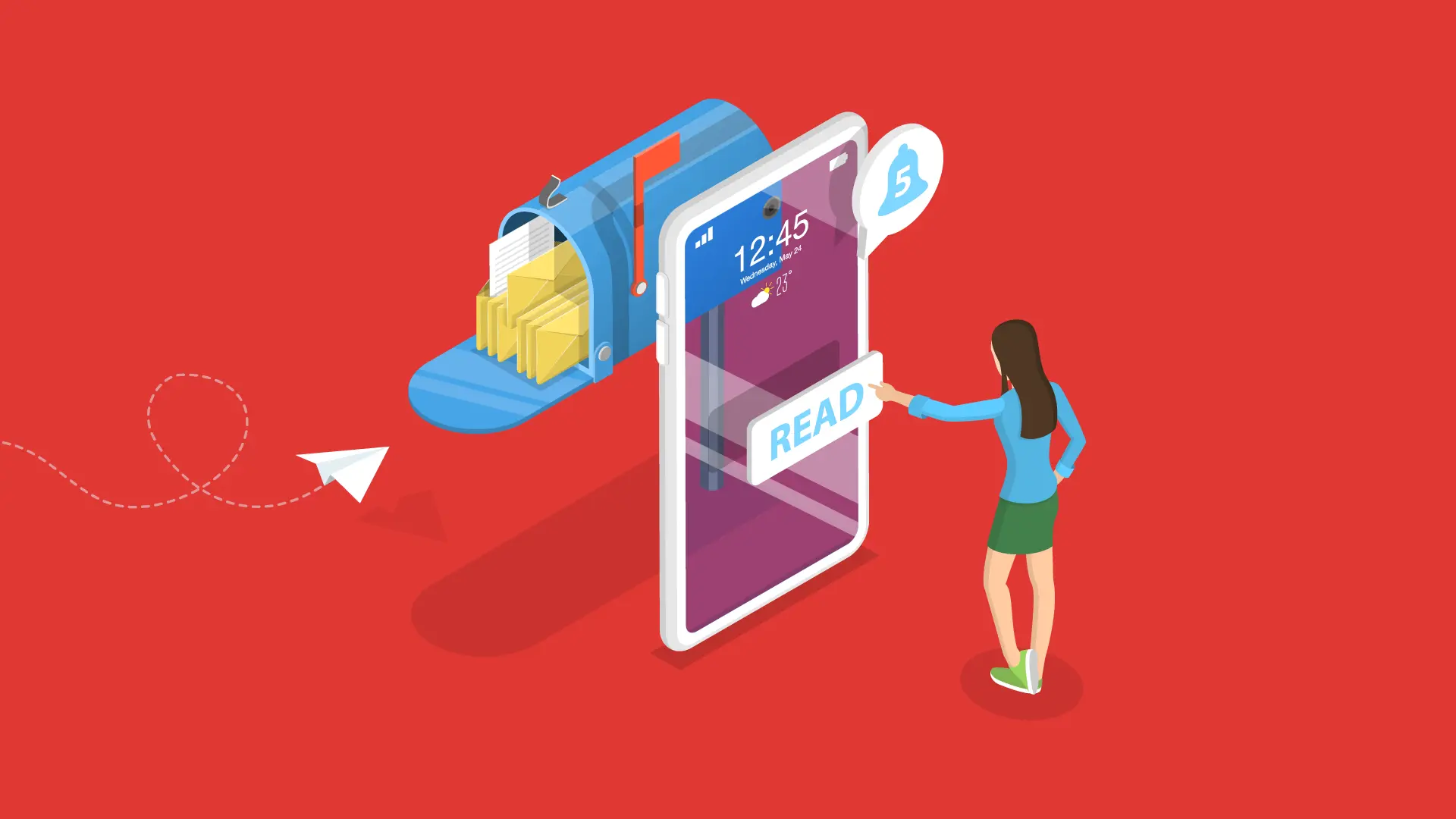
Over the years, I’ve taken a bunch of ecommerce emails and broken them down line-by-line to show readers exactly what makes them work so well.
If you’re looking for smart strategies and best practices YOU can use to make your own emails better, I’ve got a TON of email examples for you to check out with my Email of the Week article series.
Got an ecommerce email you want me to break down?
If you ever find a good email you’d like for me to break down, all you have to do is send it over to (chris@theemailcopywriter.com) with a brief message about what you liked about it.
If I choose to do the breakdown, I’ll give you a shout out and link to your site.
(Obviously the only rule is you obviously can’t pick yourself.)
Ecommerce Email Marketing Courses & Templates
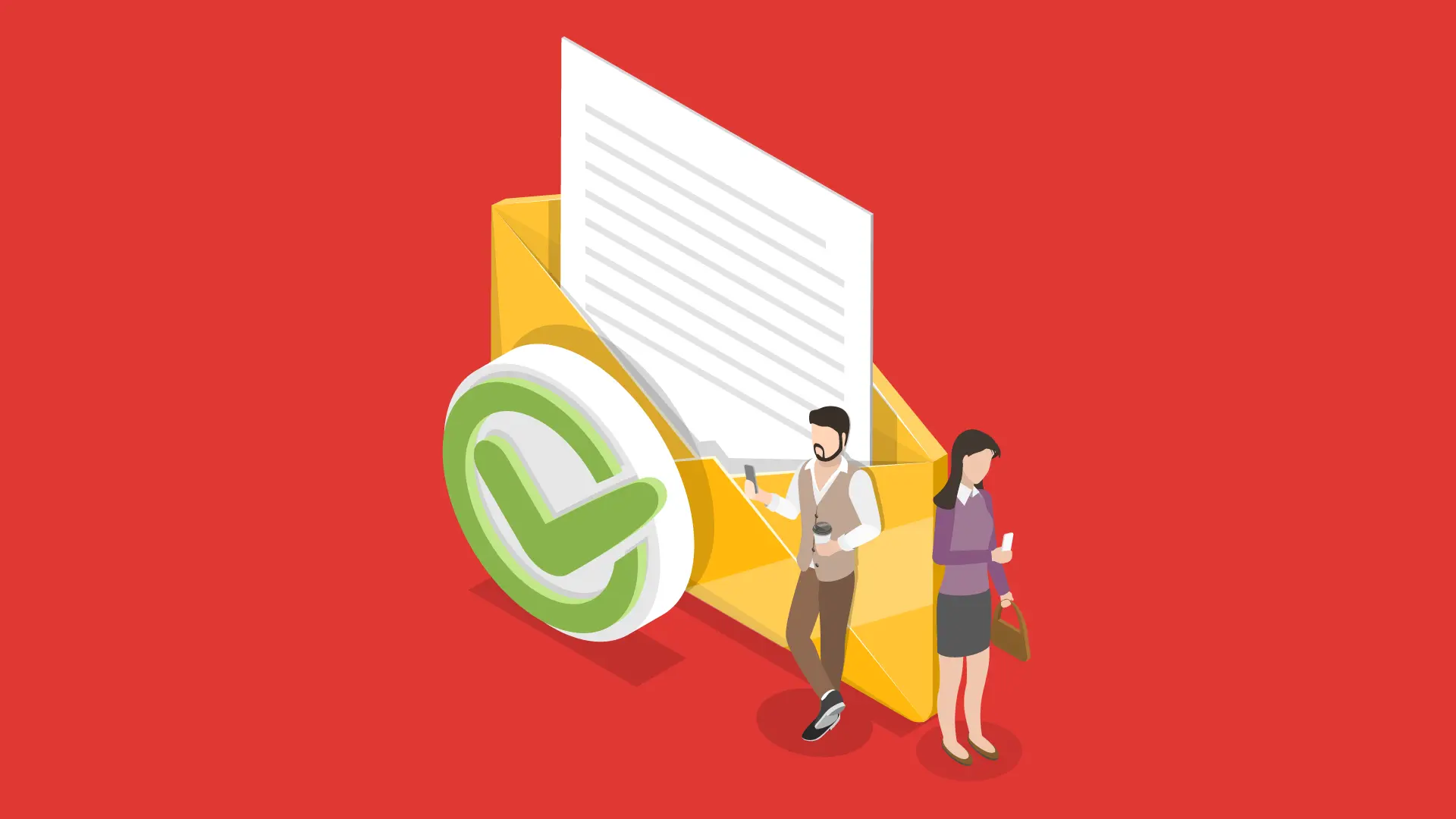
Cart Abandonment Annihilator
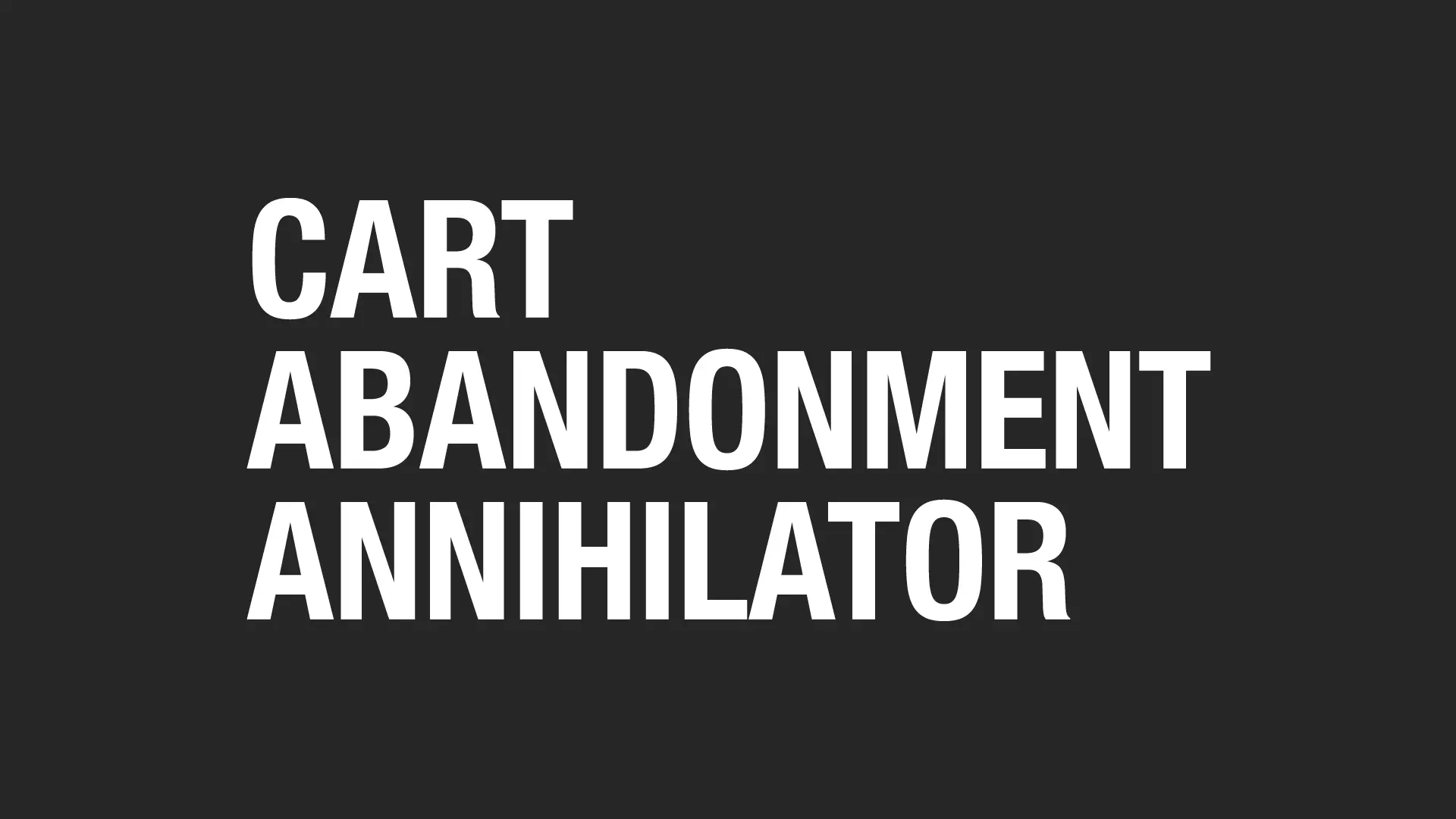
My Cart Abandonment Annihilator is the ultimate email template pack and training for anyone who wants to generate more sales, more stability and more profit out of their business.
It’s the exact high-converting cart abandonment sequence I’ve used to help my clients recover hundreds of thousands of dollars from their abandoned carts.
You can click here to buy Cart Abandonment Annihilator today.
Make It Rain Monthly
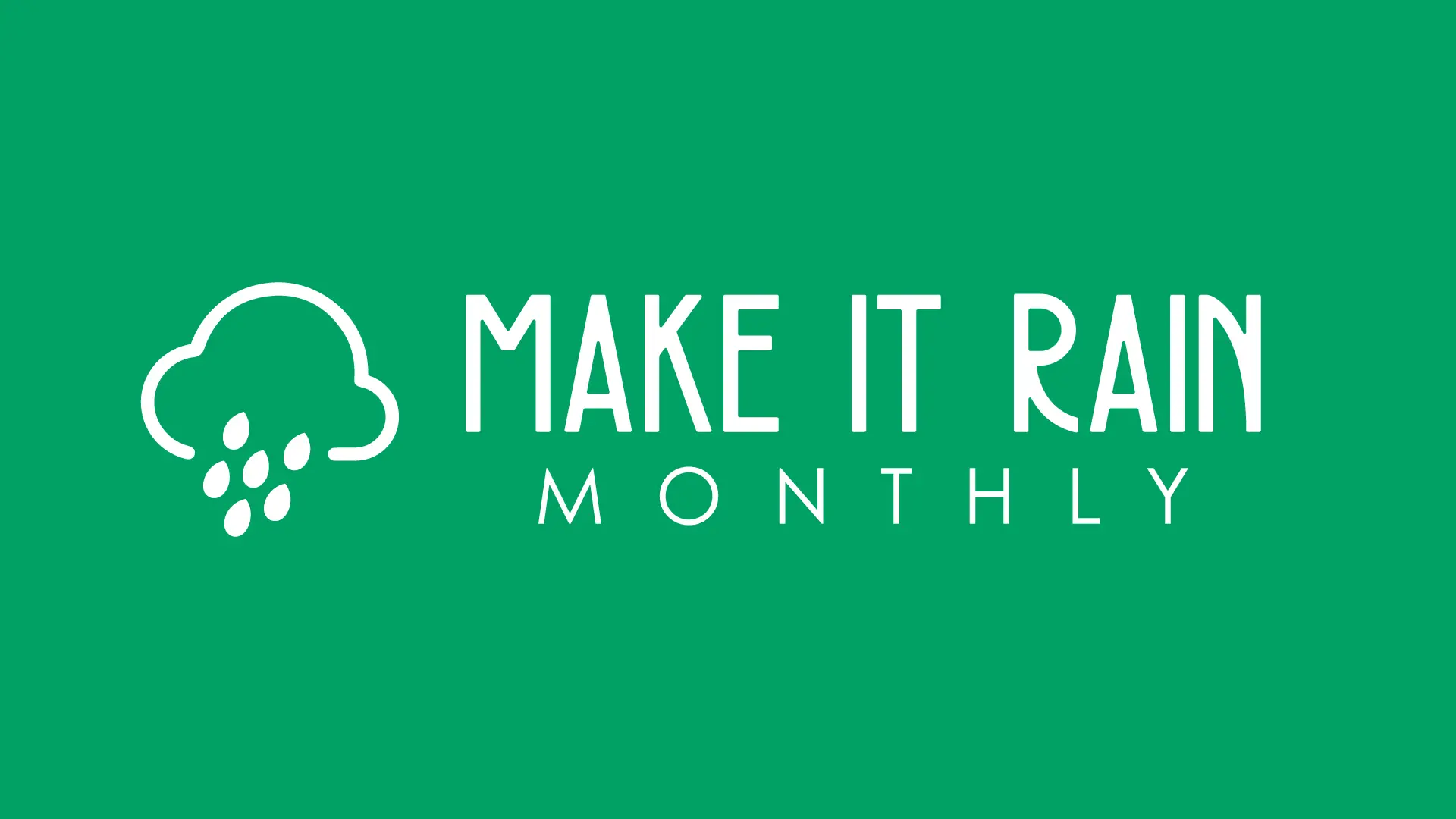
1,000 Happy Customers
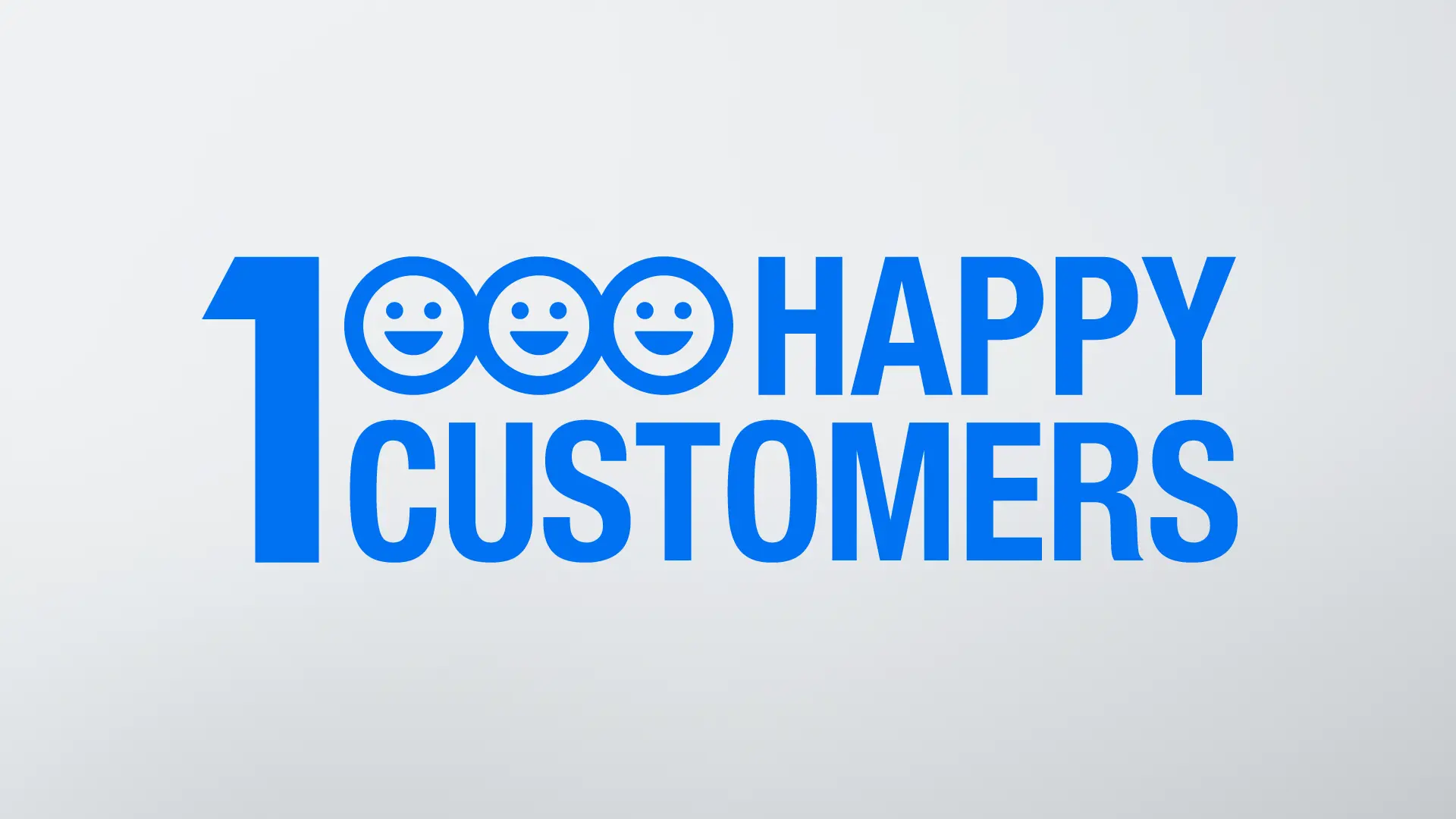
My 1,000 Happy Customers is a 4-module online course that teaches business owners how to build a responsive email list by attracting more “future customers” without spending a dime on paid ads.
If you make money online either by selling products or providing a service, the rules for list-building are all the same.
What To Do With YOUR Email Marketing
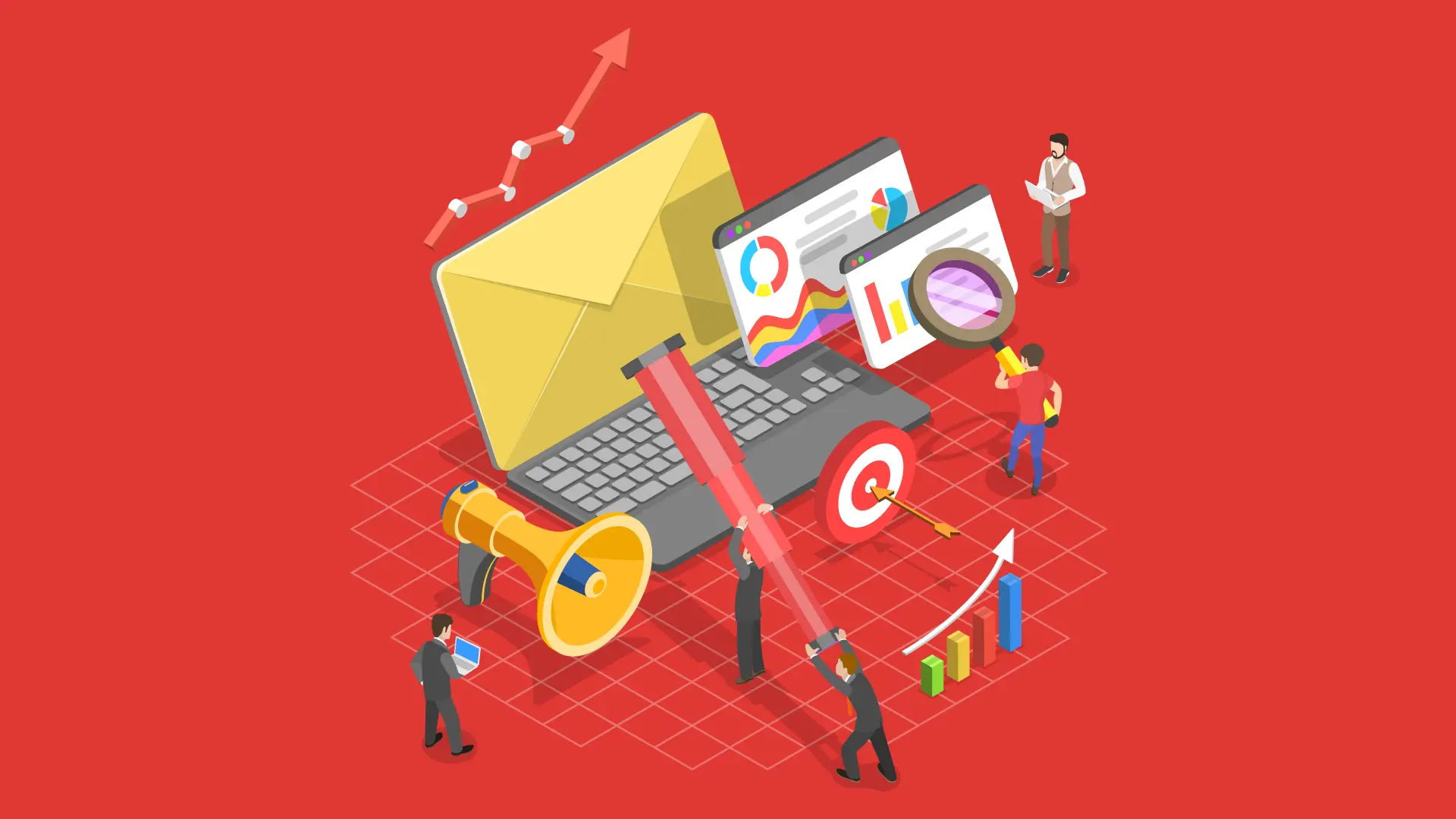
I know I threw A LOT at you with this guide…
But I needed to be absolutely sure I was giving you everything you need to kick ass with your ecommerce email marketing.
When I first started this whole email marketing journey years ago, it was pretty rough out there.
For years, I wasn’t sure of what the next day or week was going to bring.
I was ALWAYS waking up with a million fires to put out.
And I straight-up had no idea what I was doing.
All that to say, if that’s how you’re feeling…
I want you to stay the goddamn course.
I put together this guide so you don’t have to fall into as many ditches as I had to.
And I want you to use it to fast-track your way to making it rain harder than ever with more sales and bigger profits.
Use this guide to build the business of your dreams.
Use it to improve on your mistakes and shoot up your performance one day after the other.
Because I have no doubt in mind that you’ll get to wherever it is you’re headed.
So keep holding the line and trudging forward.
You got this.

